Existence and multiplicity results for some superlinear elliptic problems on RN
半线性椭圆方程
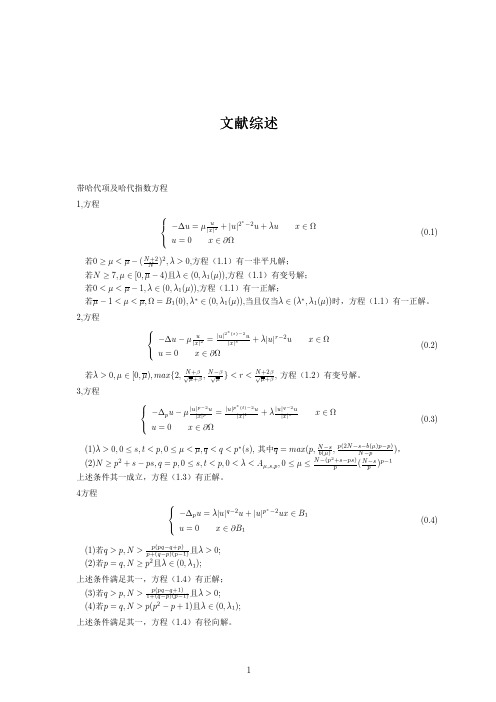
µ − a + β . K•§ (0.12) – k˜‡
ë•©zµ [1] L. Caffarelli, R. Kohn, L. Nirenberg, First order interpolation inequality with weights, Compos. Math. 53 (1984) 259–275. [2] K. Chou, C. Chu, On the best constant for a weighted Sobolev–Hardy inequality, J. Lond. Math. Soc. (2) 48 (1993) 137–151. [3] F. Catrina, Z. Wang, On the Caffarelli-Kohn-Nirenberg inequalities: Sharp constants, existence (and nonexistence), and symmetry of external functions, Comm. Pure Appl. Math. 54 (2) (2001) 229–258. [4] X.J. Huang, X.P. Wu, C.L. Tang, Multiple positive solutions for semilinear elliptic equations with critical weighted Hardy-Sobolev exponents, Nonlinear Anal. 74 (2011) 2602–2611 [5] L. Ding, C.L. Tang, Existence and multiplicity of positive solutions for a class of semilinear elliptic equations involving Hardy term and Hardy-Sobolev critical exponents, J. Math. Anal. Appl. 339 (2008) 1073–1083. [6] L. Huang, X.P. Wu, C.L. Tang, Existence and multiplicity of solutions for semilinear elliptic equations with critical weighted Hardy-Sobolev exponents, Nonlinear Anal. 71 (2009) 1916–1924. [7] P. H. Rabinowitz. Minimax methods in critical point theory with applications to differential equations, Conference Board of the Mathematical Sciences, vol. 65 Providence, RI: American Mathematical Society, 1986. [8] W. Rudin, Real and Complex Analysis, 3rd ed., McGraw-Hill, New York, 1987. [9] H. Brezis, L. Nirenberg, Positive solutions of nonlinear elliptic equations involving critical Sobolev exponents, Comm. Pure Appl. Math. 36 (4) (1983) 437–477. [10] D. Kang, G. Li, S. Peng, Positive solutions and critical dimensions for the elliptic problems involving the Caffarelli-Kohn-Nirenberg inequalities, J. Jilin. Univ. Sci. 46 (2008) 423–427.
2m阶差分方程边值问题解的存在性
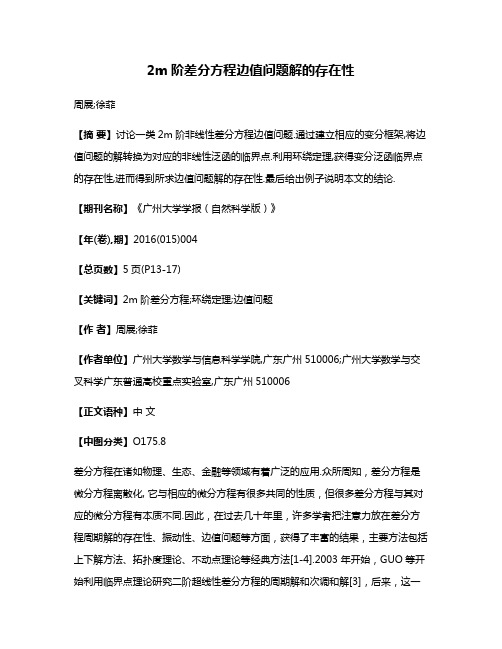
2m阶差分方程边值问题解的存在性周展;徐菲【摘要】讨论一类2m阶非线性差分方程边值问题.通过建立相应的变分框架,将边值问题的解转换为对应的非线性泛函的临界点.利用环绕定理,获得变分泛函临界点的存在性,进而得到所求边值问题解的存在性.最后给出例子说明本文的结论.【期刊名称】《广州大学学报(自然科学版)》【年(卷),期】2016(015)004【总页数】5页(P13-17)【关键词】2m阶差分方程;环绕定理;边值问题【作者】周展;徐菲【作者单位】广州大学数学与信息科学学院,广东广州510006;广州大学数学与交叉科学广东普通高校重点实验室,广东广州510006【正文语种】中文【中图分类】O175.8差分方程在诸如物理、生态、金融等领域有着广泛的应用.众所周知,差分方程是微分方程离散化, 它与相应的微分方程有很多共同的性质,但很多差分方程与其对应的微分方程有本质不同.因此,在过去几十年里,许多学者把注意力放在差分方程周期解的存在性、振动性、边值问题等方面,获得了丰富的结果,主要方法包括上下解方法、拓扑度理论、不动点理论等经典方法[1-4].2003 年开始,GUO等开始利用临界点理论研究二阶超线性差分方程的周期解和次调和解[3],后来,这一方法被用来研究差分方程的边值问题.设R, Z分别表示实数集和整数集.对任给的a, b∈Z且a≤b,定义Z(a,b)={a,a+1,…,b},Z(a)={a,a+1,…}.Δ为向前的差分算子,定义为Δun=un+1-un,Δkun=Δ(Δk-1un), k∈Z(2).设T∈Z(2), 在参考文献[5]中,ATICI 等讨论了如下差分方程的周期边值问题:这里f∈C(Z(1,T)×R,R).方程(1)作为一个二阶微分方程的离散模型,被应用于很多领域,如空气动力学、核物理等.运用上下解方法,ATICI等建立了边值问题(1)存在唯一解的条件.2014年, LIU等在参考文献[6]中利用临界点理论研究了四阶差分边值问题的解的存在性与不存在性条件.其中δ表示正奇数的比,f∈C(Z(1,T)×R, R).在物理学中方程(2)经常被用来模拟弹性梁的弯曲程度.2009年,ZOU等在参考文献[7] 中利用临界点理论讨论了以下2m阶差分方程:Δm(pn-mΔmun-m)+(-1)m+1f(n,un)=0,n∈Z(1,T)在边值条件下的解的存在情况.其中 T和m是任给的正整数,且T>m.然而,可以看到大部分参考文献[5-6,8-12]都是研究二阶或者四阶差分方程的, 对一般高阶差分方程的研究相对来说较少.受文献[4-7,13]的启发,本文讨论更一般的2m阶差分方程Δm(pn-mΔmun-m)+(-1)m+1Δ(g(Δun-1))+(-1)m+1f(n,un)=0, n∈Z(1,T)在边值条件下的解的存在性.其中g∈C(R, R), f(n,·)∈C(R,R)对任意n∈Z(1,T).设m, T∈Z(1)且T>m, 定义向量空间Ω={u={un}|un∈R,n∈Z(1-m,T+m)},对任意的u,v∈Ω,a,b∈R有au+bv={aun+bvn}.E={u={un}∈Ω|u1-i=u1,uT+i=uT,i∈Z(1,m)}是Ω的一个线性子空间.易知E与RT是同构的,因此,在空间E上可以定义内积如下:由E上的内积可以诱导空间E上的范数:对任意的r≥1, 可以定义空间E上的另一种范数:因为E是有限维空间,所以存在2个常数c2(r)≥c1(r)>0使得c1(r)‖u‖2≤‖u‖r≤c2(r)‖u‖2,∀u∈E这里u.显然J ∈C1(E,R),其中C1(E, R)表示Hilbert空间E上Fréchet可微且其Fréchet导数是连续的泛函集合.根据E的定义, 有f(n,un),∀n∈Z(1,T).因此,u是泛函J的一个临界点当且仅当u满足边值问题(5)~(6).记u={un}∈E,由于E与RT同构,所以u可写成u=(u1,u2,…,uT)*∈RT.那么存在T×T阶矩阵A 使得显然, A是一个半正定矩阵.令σ+(A)为A的所有正特征值构成的集合.定义}.设W, Y分别为A的0特征值和所有正特征值对应的特征向量空间,则W={(u1,u2,…,uT)*∈RT|ui=w,w∈R,i∈Z(1,T)},且下面介绍一些临界点理论的基本概念和基本结果.定义1 设S是一个实Banach空间, J∈C1(S,R)满足Palais-Smale条件 (简称P.S.条件),如果对任给的{un}⊂S,{J(un)}有界,当n→∞时J′(un)→0蕴含{un}有收敛的子列.记Bρ={y∈S: ‖y‖<ρ}是以0为中心,半径为ρ的开球,‖y‖=ρ}为Bρ的边界.引理1(环绕定理[14]) 设S=S1⨁S2是一个Hilbert空间, 其中,S1是S的一个有限维的子空间. 若J∈C1(S,R)满足P.S.条件且满足:(1)存在常数σ>0和ρ>0使得J|∂Bρ∩S2≥σ;(2)存在e∈∂B1∩S2和常数R1>ρ使得J|∂Q≤0, 其中⨁{re|0<r<R1}.那么J存在临界值c≥σ, 这里表示∂Q上的恒等算子.定理1 如果以下假设都满足:(A1)f(n,v),g(v)是关于v连续, 且g(0)=0, G(v)≥0对v∈R成立,其中n∈Z(1,T); (A2)对任给的n∈Z(1-m,T),pn>0;(A3)当n∈Z(1,T),v∈R时F(n,v)≥0且(A4)存在正常数R2和β>2使得0<βF(n,v)≤vf(n,v), n∈Z(1,T),|v|≥R2;(A5)存在正常数R3和α<β使得0<sg(s)≤αG(s),n∈Z(1,T),|s|≥R3.那么边值问题(5)~(6)至少存在2个非平凡解.注1 由(A4)知,存在正常数使得,∀(n,v)∈Z(1,T)×R.注2 由(A5)、(A1)知,存在正常数得,∀s∈R.记p*=max{pn, n∈Z(1-m,T)},p*=min{pn, n∈Z(1-m, T)}.则p*≥p*>0.为了方便定理1的证明, 需要验证下面的引理.引理2 假设(A1)~(A5)都满足, 那么泛函J满足P.S.条件.证明设{u(l)}l∈Z(1)⊂E是一个P.S.序列,则存在常数C使得|J(u(l))|≤C,∀l∈Z(1).根据式(11),注1和注2有‖a1c1β(β)‖‖‖u(l)‖α-‖注意到J(u(l))≥-C, 则由式(13)得‖‖u(l)‖2-‖C.因为β>max{2,α}, 所以存在常数N0>0使得‖u(l)‖≤N0,∀l∈N. 因此, {u(l)}是E 上的有界序列.因为E是有限维的, 所以 {u(l)}存在收敛的子列.即J满足P.S.条件. 定理1的证明由(A3)知f(n,0)=0, n∈Z(1,T), 结合(A1)中g(0)=0知0是 J的一个临界点, 且J(0)=0.式 (13)蕴含lim‖u‖→+∞J(u)=-∞, 因此,J在E上有上界,-J是强制的.记cmax为{J(u)}的上确界,对任给的c0>|cmax|, 存在一个常数t>0,使得|J(u)|>c0>|cmax|,‖u‖>t.根据J在E上的连续性, 存在使得即是J的一个临界点. 可断定cmax>0. 事实上, 由(A3)知存在和η>0使得F(n,u)≤ε|u|2,|u|≤η.对任给的u=(u1,u2,…,uT)*∈Y,‖u‖≤η有|un|≤η,n∈Z(1,T). 因此,‖u‖2-ε‖u‖2=‖u‖2令,∀u∈Y∩∂Bη有J(u)≥σ>0,所以cmax=supu∈EJ(u)≥σ>0, 故cmax对应的临界点是边值问题(5)~(6)的一个非平凡解. 要得到另一个非平凡解可以利用引理1.由引理2 知J满足P.S.条件.其次,令S2=Y,S1=W,则E=S1+S2.由式(14)知J|Y∩∂Bη≥σ,因此J满足引理1的第一个条件.为了验证J满足引理1 的第二个条件,设e∈∂B1∩Y,对任给的w∈W,r∈R,令u=re+w,有‖‖w‖β.定义,‖w‖β.可以得到,因此k1(r),k2(w)有上界.注意到,则存在一个正常数R4>η使得J(u)≤0,∀u∈∂Q成立, 其中⨁{re|0<r<R4}.由引理1知J存在一个临界值c≥σ>0,其中}.令使得c. 如果,那么定理1的结论成立.不然,有,也即).令h=id,有.与上述方法类似,可以将e换成-e∈∂B1∩Y,同样存在一个常数R5>η使得∀u∈∂Q1,J(u)≤0成立,其中⨁{-re|0<r<R5},再次利用引理1可以得到J存在一个临界值c′≥σ>0,其中}.同理,存在u′∈E使得J(u′)=c′,如果定理1的结论成立,否则有,即,也即).令h=id,有因为J|∂Q≤0与J|∂Q1≤0,所以u′一定是Q和Q1的内点,然而Q∩Q1⊂W且对任给的u∈W都有J(u)≤0成立,即c′≤0与c′>0矛盾,因此结论成立,定理1 得证.例1 设T为一正整数, 考虑四阶差分方程边值问题Δu-1=Δu0=0,ΔuT=ΔuT+1=0对照式(5), 有因此易知边值问题(15)~(16)满足条件(A1)~(A5), 其中α=4,β=6, 由定理1 知至少存在2个非平凡解.【相关文献】[1] AGARWAL R P, O′REGAN D. Singular discrete (n,p) boundary value problems[J]. Appl Math Lett, 1999, 12(8): 113-119.[2] AGARWAL R P, WONG F H. Upper and lower solutions method for higher-orderdiscrete boundary values problems[J]. Math Ineq Appl, 1998, 1(4): 551-557.[3] GUO Z M, YU J S. Existence of periodic and subharmonic solutions for second-order superlinear difference equations[J]. Sci China Ser A, 2003, 46(4): 506-515.[4] ZHOU Z, YU J S, CHEN Y M. Periodic solutions of a 2nth-order nonliner difference equation[J]. Sci China Math, 2010, 53(1): 41-50.[5] ATICI F M, CABADA A. Existence and uniqueness results for discrete second-order periodic boundary value problems[J]. Comput Math Appl, 2003, 45(6/9): 1417-1427. [6] LIU X, ZHANG Y B, SHI H P. Nonexistence and existence results for a class of fourth-order difference Neumann boundary value problems[J]. Indag Math, 2015, 26(1): 293-305.[7] ZOU Q R, WENG P X. Solutions of 2nth-order boundary value problem for difference equation via variational method[J]. Adv Differ Equ, 2009, Art. ID 730484,10pp.[8] 李龙图, 翁佩萱. 二阶泛函差分方程边值问题[J]. 华南师范大学学报:自然科学版,2003(3): 20-24.LI L T, WENG P X. Boundary value problems of second order functional difference equation[J]. J South China Normal Univ: Nat Sci Edi, 2003(3): 20-24.[9] 梁海华, 翁佩萱. 一类四阶差分边值问题解的存在性与临界点方法[J]. 高校应用数学学报, 2008, 23(1): 67-72.LIANG H H, WENG P X. Existence of solutions for a fourth-order difference boundary value problem and critical point method[J]. Appl Math J Chin Univ Ser A, 2008, 23(1): 67-72.[10]ZHENG B, ZHANG Q Q. Existence and multiplicity of solutions of second-order difference boundary value problems[J]. Act Appl Math, 2010, 110(1): 131-152.[11]LIU X, ZHANG Y B, SHI H P. Periodic solutions for fourth-order nonlinear functional difference equations[J]. Math Meth Appl Sci, 2015, 38(1): 1-10.[12]LIU X, ZHANG Y B, SHI H P. Nonexistence and existence results for a class of fourth-order difference Dirichlet boundary value problems[J]. Math Meth Appl Sci, 2015, 38(4): 691-700.[13]BONANNO G, CANDITO P, D′AUGI G. Variational methods on finite dimentional banach spaces and discrete problems[J]. Adv Nonlin Stud, 2014, 14(4): 915-939.[14]RABINOWITZ P H. Minimax methods in critical point theory with applications to differential equations[M]. USA: CBMS, American Mathematical Society, 1986.。
existence and multiplicity results
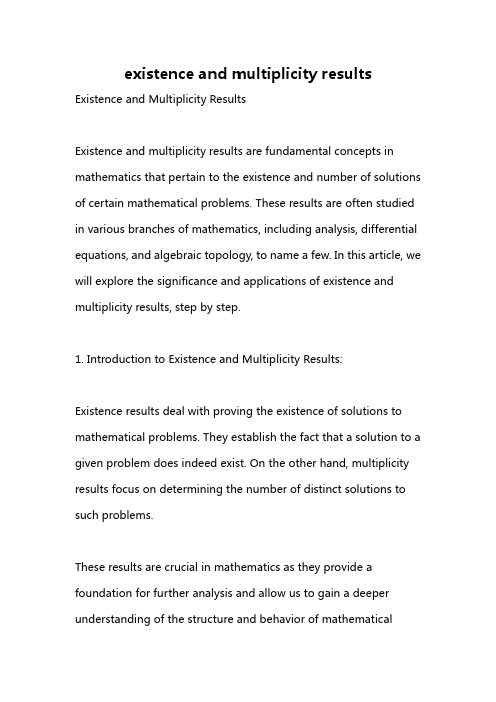
existence and multiplicity results Existence and Multiplicity ResultsExistence and multiplicity results are fundamental concepts in mathematics that pertain to the existence and number of solutions of certain mathematical problems. These results are often studied in various branches of mathematics, including analysis, differential equations, and algebraic topology, to name a few. In this article, we will explore the significance and applications of existence and multiplicity results, step by step.1. Introduction to Existence and Multiplicity Results:Existence results deal with proving the existence of solutions to mathematical problems. They establish the fact that a solution to a given problem does indeed exist. On the other hand, multiplicity results focus on determining the number of distinct solutions to such problems.These results are crucial in mathematics as they provide a foundation for further analysis and allow us to gain a deeper understanding of the structure and behavior of mathematicalsystems. They are used to address a wide range of problems, from solving differential equations and boundary value problems, to studying the existence of critical points in optimization and variational problems.2. Theoretical Framework and Methods:To prove the existence and multiplicity of solutions, various mathematical techniques have been developed over the years. These techniques include fixed point theorems, variational methods, topological methods, and bifurcation theory, among others.Fixed point theorems, such as the Banach fixed point theorem, play a significant role in proving the existence of solutions. These theorems guarantee the existence of a point that remains invariant under a given map or transformation. By establishing a suitable framework and constructing appropriate mappings, one can apply fixed point theorems to demonstrate the existence of solutions for a wide range of problems.Variational methods involve optimizing functionals subjected tocertain constraints. By considering the critical points of these functionals, one can identify solutions to the original problem. Variational methods provide a powerful tool in the study of existence and multiplicity of solutions, particularly in the field of partial differential equations.Topological methods, such as degree theory and index theory, are used to establish the number of solutions to a given problem. These methods utilize topological concepts to assign a numerical index or degree to a map, representing the number of times the map wraps around a particular point. By analyzing the index or degree of a mapping, one can determine the number of solutions that exist.Bifurcation theory studies the qualitative changes in the behavior of solutions as certain parameters of a problem are varied. It explores how the number and types of solutions change as the parameters cross critical values. Bifurcation theory offers valuable insights into the multiplicity and existence of solutions, particularly when studying dynamic systems.3. Applications and Importance:The importance of existence and multiplicity results can be seen in various fields of mathematics as well as in applications to science and engineering. For example, in the study of differential equations, existence and multiplicity results enable us to understand the behavior and stability of solutions. They are essential in modeling physical phenomena, such as heat transfer, fluid dynamics, and population dynamics.In algebraic topology, existence and multiplicity results help us understand the structure and properties of topological spaces. They provide insights into the connectivity and dimensionality of these spaces, aiding in the classification and characterization of geometric objects.Existence and multiplicity results are also crucial in optimization problems. By determining the existence and number of critical points, one can identify the optimal solution to a given problem, whether it is maximizing or minimizing a certain objective function.4. Conclusion:In conclusion, existence and multiplicity results are fundamental concepts in mathematics with significant applications in various fields. They provide a theoretical framework and techniques for proving the existence and determining the number of solutions of mathematical problems. These results have far-reaching implications, enabling us to understand the behavior of solutions in differential equations, analyze the structure of topological spaces, and find optimal solutions in optimization problems. By exploring and applying existence and multiplicity results, mathematicians continue to advance our understanding of the mathematical world and its connections to real-world phenomena.。
Existence of Homoclinic Solutions
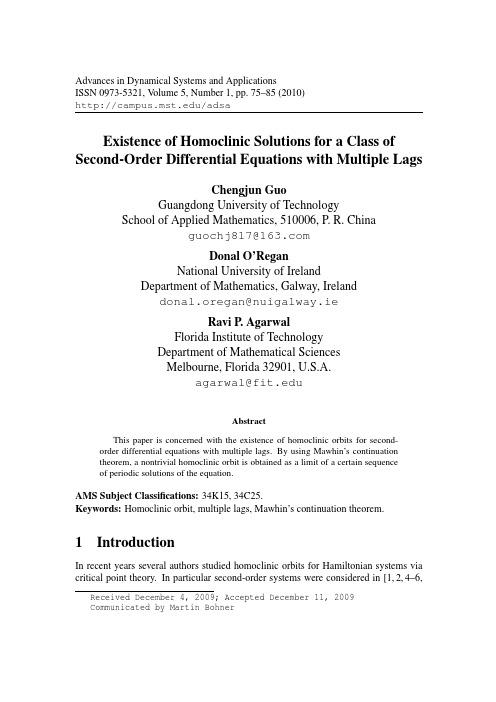
Advances in Dynamical Systems and ApplicationsISSN0973-5321,V olume5,Number1,pp.75–85(2010)/adsaExistence of Homoclinic Solutions for a Class of Second-Order Differential Equations with Multiple LagsChengjun GuoGuangdong University of TechnologySchool of Applied Mathematics,510006,P.R.Chinaguochj817@Donal O’ReganNational University of IrelandDepartment of Mathematics,Galway,Irelanddonal.oregan@nuigalway.ieRavi P.AgarwalFlorida Institute of TechnologyDepartment of Mathematical SciencesMelbourne,Florida32901,U.S.A.agarwal@AbstractThis paper is concerned with the existence of homoclinic orbits for second-order differential equations with multiple lags.By using Mawhin’s continuationtheorem,a nontrivial homoclinic orbit is obtained as a limit of a certain sequenceof periodic solutions of the equation.AMS Subject Classifications:34K15,34C25.Keywords:Homoclinic orbit,multiple lags,Mawhin’s continuation theorem.1IntroductionIn recent years several authors studied homoclinic orbits for Hamiltonian systems via critical point theory.In particular second-order systems were considered in[1,2,4–6, Received December4,2009;Accepted December11,2009Communicated by Martin Bohner76Chengjun Guo,Donal O’Regan and Ravi P.Agarwal 12–16,19]andfirst-order systems in[3,7–9,11,17,18].In this paper we consider the existence of homoclinic orbits for FDE by using Mawhin’s continuation theorem.In particular we discuss the existence of homoclinic orbits for the equationx (t)+a1(t)x (t)−a2(t)x(t)=g(t,x(t−τ1),x(t−τ2),···,x(t−τn))+f(t),(1.1) whereτi(i=1,2,···,n)are constants,a1(t)and a2(t)are real continuous functions defined on R with positive period T,f:R→R is a continuous and bounded function, g(t,x1,x2,···,x n)∈C(R×R×R×···×R,R),g(t,0,0,···,0)=0,and is T-periodic in t.A solution x of(1.1)is said to be homoclinic(to0)if x(t)→0as t→±∞.In addition,if x≡0then x is called a nontrivial homoclinic solution.This paper is largely motivated by the work of Rabinowitz[15]in which the exis-tence of nontrivial homoclinic solutions for the second-order Hamiltonian system¨q+V q(t,q)=0was proved.For the sake of completeness,wefirst state Mawhin’s continuation theorem [10].Assume X and Y are two Banach spaces,L:Dom L⊂X→Y is a linear mapping and N:X→Y is a continuous mapping.The mapping L will be called a Fredholm mapping of index zero if dim Ker L=codim Im L<+∞and Im L is closed in Y.If L is a Fredholm mapping of index zero,then there exist continuous projections P:X→X and Q:Y→Y such that Im P=Ker L and Im L=Ker Q=Im(I−Q). It follows that L|Dom L∩Ker P:(I−P)X→Im L has an inverse which will be denoted by K P.IfΩis an open and bounded subset of X,the mapping N will be called L-compact onΩif QN(Ω)is bounded and K P(I−Q)N(Ω)is compact.Since Im Q is isomorphic to Ker L,there exists an isomorphism J:Im Q→Ker L.Theorem1.1(Mawhin’s continuation theorem[10]).Let L be a Fredholm mapping of index zero,and let N be L-compact onΩ.Suppose(1)for eachλ∈(0,1)and x∈∂Ω,Lx=λNx;(2)for each x∈∂Ω∩Ker(L),QNx=0and deg(QN,Ω∩Ker(L),0)=0.Then the equation Lx=Nx has at least one solution inΩ∩D(L).2Main ResultNow we make the following assumptions on a1(t),a2(t)and f(t):(H1)0≤m1≤|a1(t)|≤M1;(H2)M2=maxt∈[0,T]a2(t)≥a2(t)≥m2=mint∈[0,T]a2(t)>0;Existence of Homoclinic Solutions77(H3)f:R→R is continuous and bounded,f≡0andR |f(t)|2dt12≤η,whereη>0is a positive constant.Our main result is the following theorem. Theorem2.1.Suppose(H1)–(H3)and assume(H4)|g(t,x1,x2,···,x n)|≤rni=1|x i|and m2−M214−2rn>0.Then system(1.1)possesses a nontrivial homoclinic solution x∈C2(R,R)such that x (t)→0as t→±∞.In order to prove the main theorem we need some preliminaries.For each k∈N, setX k:={x|x∈C1(R,R),x(t+2kT)=x(t),∀t∈R}and x(0)(t)=x(t),define the norm on X k byx =maxmaxt∈[−kT,kT]|x(t)|,maxt∈[−kT,kT]|x (t)|,and setY k:={y|y∈C(R,R),y(t+2kT)=y(t),∀t∈R}.We define the norm on Y k as y 0=maxt∈[−kT,kT]|y(t)|.Thus both(X k, · )and(Y k, · 0) are Banach spaces.Remark2.2.If x∈X k,then it follows that x(i)(0)=x(i)(2kT)(i=0,1).In the works of Izydorek and Janczewska[12]and Tanaka[19],a homoclinic so-lution of(1.1)is obtained as a limit,as k→±∞,of a certain sequence of functions x k∈X k.So here we will consider a sequence of systems of functional differential equationsx (t)+a1(t)x (t)−a2(t)x(t)=g(t,x(t−τ1),x(t−τ2),···,x(t−τn))+f k(t),(2.1) where for each k∈N,f k:R→R is a2kT-periodic extension of the restriction of f to the interval[−kT,kT]and x k is a2kT-periodic solution of(2.1)obtained via Mawhin’s continuation theorem.Define the operators L k:X k→Y k and N k:X k→Y k byL k x(t)=x (t),t∈R,(2.2) andN k x(t)=−a1(t)x (t)+a2(t)x(t)+g(t,x(t−τ1),x(t−τ2),···,x(t−τn))+f k(t),t∈R.(2.3)78Chengjun Guo,Donal O’Regan and Ravi P.Agarwal Clearly,Ker L k={x∈X k:x(t)=c∈R}(2.4)andIm L k=y∈Y k:kT−kTy(t)dt=0(2.5)is closed in Y k.Thus L k is a Fredholm mapping of index zero.Let us define P k:X k→X k and Q k:Y k→Y k/Im(L k)byP k x(t)=12kTkT−kTx(t)dt=x(0),t∈R,(2.6)for x=x(t)∈X andQ k y(t)=12kTkT−kTy(t)dt,t∈R(2.7)for y=y(t)∈Y k.It is easy to see that Im P k=Ker L k and Im L k=Ker Q k=Im(I k−Q k).It follows that L k|Dom Lk∩Ker P k :(I k−P k)X k→Im L k has an inversewhich will be denoted by K Pk.LetΩk be an open and bounded subset of X k.We can easily see that Q k N k(Ωk)isbounded and K Pk (I k−Q k)N k(Ωk)is compact.Thus the mapping N k is L-compact onΩk.That is,we have the following result.Lemma2.3.Let L k,N k,P k and Q k be defined by(2.2),(2.3),(2.6)and(2.7)respec-tively.Then L k is a Fredholm mapping of index zero and N k is L-compact onΩk,where Ωk is any open and bounded subset of X k.In order to prove our main result,we need the following lemma[15].Lemma2.4(See Remark2.2and[15]).There is a positive constant such that for each k∈N and x∈X k the following inequality holds:max t∈[−kT,kT]|x(t)|≤kT−kT(|x(t)|2+|x (t)|2)dt12.Now,we consider the auxiliary equationx (t)+λ[a1(t)x (t)−a2(t)x(t)]=λ[g(t,x(t−τ1),x(t−τ2),···,x(t−τn))+f k(t)],(2.8) where0<λ<1.Existence of Homoclinic Solutions79 Lemma2.5.Suppose that the conditions of Theorem2.1are satisfied.If x k(t)is a2kT-periodic solution of Eq.(2.8),then there are positive constants D i,i=0,1,which are independent ofλ,such thatx(i)k0≤D i,t∈[−kT,kT],i=0,1.(2.9) Proof.Suppose that x k is a2kT-periodic solution of Eq.(2.8).We have from(2.8)thatkT −kT [xk(t)+λa1(t)xk(t)−λa2(t)x k(t)]x k(t)dt=λkT−kT[g(t,x k(t−τ1),x k(t−τ2),···,x k(t−τn))+f k(t)]x k(t)dt.(2.10)From(2.10),we havekT −kT {|xk(t)|2+λa2(t)|x k(t)|2}dt=−λkT−kT[g(t,x k(t−τ1),x k(t−τ2),···,x k(t−τn))+f k(t)−a1(t)xk(t)]x k(t)dt≤λkT−kT |g(t,x k(t−τ1),x k(t−τ2),···,x k(t−τn))|2dt12×kT−kT |x k(t)|2dt12+λkT−kT|f k(t)|2dt12+M1kT−kT|xk(t)|2dt12×kT−kT |x k(t)|2dt12≤2rnλkT−kT |x k(t)|2dt+λη+M1kT−kT|xk(t)|2dt12 kT−kT|x k(t)|2dt12,soλm2−M214kT−kT|x k(t)|2dt≤λkT−kT|xk(t)|2dt12−M12kT−kT|x k(t)|2dt12 2+λa2(t)−M214kT−kT|x k(t)|2dt+1λ−λkT−kT|xk(t)|2dt ≤2rnλkT−kT|x k(t)|2dt+ηλkT−kT|x k(t)|2dt12,80Chengjun Guo,Donal O’Regan and Ravi P .Agarwalwhich givesm 2−M 214−2rnkT−kT |x k (t )|2dt ≤ηkT−kT|x k (t )|2dt 12.(2.11)From (H 4)and (2.11),there exists a positive constant C 1such thatkT−kT |x k (t )|2dt ≤η2(m 2−M 214−2rn )2=C 1.(2.12)From (2.8),we havekT−kT[x k (t )+λa 1(t )xk (t )−λa 2(t )x k (t )]x k (t )dt=λkT−kT[g (t,x k (t −τ1),x k (t −τ2),···,x k (t −τn ))+f k (t )]x k (t )dt,(2.13)som 1kT−kT|x k (t )|2dt≤kT−kT |a 1(t )||x k (t )|2dt ≤(M 2+2rn )kT−kT |x k (t )|2dt 12+ηkT−kT|x k (t )|2dt12≤[(M 2+2rn )C 1+η]kT−kT|x k (t )|2dt 12,and as a result there exists a positive constant C 2such thatkT−kT|x k (t )|2dt ≤C 2.(2.14)Moreover,for x ∈X k and t,τ∈[−kT,kT ],we have|x (t )|≤x (τ)+ t τx (s )ds .(2.15)Integration of (2.15)over t −12,t +12shows|x (t )|≤ t +12t −12|x (τ)|dτ+t +12t −12t τx (s )dsdτ≤2t +12t −12(|x (τ)|2+|x (t )|2)dτ12.(2.16)Existence of Homoclinic Solutions 81Hence (2.15)and (2.16)implymax t ∈[−kT,kT ]|x (t )|≤kT−kT(|x (t )|2+|x (t )|2)dt 12,x ∈X k ,(2.17)where is given in Lemma 2.4.From Lemma 2.4,(2.12)and (2.14),we havemax t ∈[−kT,kT ]|x k (t )|≤kT−kT(|x k (t )|2+|x k (t ))|2dt 12≤ (C 1+C 2)12=D 0.(2.18)On the other hand,we have from (2.8)thatkT−kT[x k (t )+λa 1(t )x k (t )−λa 2(t )x k (t )]xk (t )dt=λkT−kT[g (t,x k (t −τ1),x k (t −τ2),···,x k (t −τn ))+f k (t )]x k (t )dt,(2.19)so we have kT−kT|x k (t )|2dt≤kT−kT|x k (t )|2dt12M 1 kT−kT|x k (t )|2dt 12+M 2kT−kT|x k (t )|2dt12+ kT−kT |g (t,x k (t −τ1),x k (t −τ2),···,x k (t −τn ))|2dt 12×kT−kT |x k (t )|2dt12+ kT−kT|f k (t )dt12kT−kT|x k (t )|2dt12≤[(2rn +M 2)C 1+M 1 C 2+η]kT−kT|x k (t )|2dt12,and as a result there exists a positive constant C 4such thatkT−kT|x k (t )|2dt ≤[(2rn +M 2) C 1+M 1C 2+η]2=C 4.(2.20)From Lemma 2.4and (2.20),we havemaxt ∈[−kT,kT ]|x k (t )|≤kT−kT(|x k (t )|2+|x k (t )|2)dt 12≤ (C 2+C 4)12=D 1.(2.21)The proof iscomplete.82Chengjun Guo,Donal O’Regan and Ravi P.Agarwal Lemma2.6.Let k∈N.If(H1)–(H4)hold,then the system(2.1)possesses a2kT-periodic solution.Proof.Suppose that x is a2kT-periodic solution of Eq.(2.8).By Lemma2.5,there exist positive constants D i(i=0,1)which are independent ofλsuch that(2.9)is true.Consider any positive constantαk>max0≤i≤1{D i}+ξ,whereξ=maxt∈R|f(t)|.SetΩk:={x∈X k: x <αk}.We know that L k is a Fredholm mapping of index zero and N k is L-compact onΩk (see[2]).RecallKer(L k)={x∈X k:x(t)=c∈R}and the norm on X k isx =maxmaxt∈[−kT,kT]|x(t)|,maxt∈[−kT,kT]|x (t)|.Then we havex=αk or x=−αk for x∈∂Ωk∩Ker(L k).(2.22) From(H4),we have(ifαk is chosen large enough)a2(t)αk+g(t,αk,αk,···,αk)− f k 0>0t∈[−kT,kT](2.23) andx (t)=0,∀x∈∂Ωk∩Ker(L k).(2.24) Finally from(2.3),(2.7)and(2.22)–(2.24),we have(Q k N k x)=12kTkT−kT[−a1(t)x (t)+a2(t)x(t)+g(t,x(t−τ1),x(t−τ2),···,x(t−τn))+f k(t)]dt=12kTkT−kT[a2(t)x(t)+g(t,x(t−τ1),x(t−τ2),···,x(t−τn))+f k(t)]dt=0,∀x∈∂Ωk∩Ker(L k).Then,for any x∈Ker L k∩∂Ωk andη∈[0,1],we havexH(x,η)=−ηx2−x2kT(1−η)kT−kT[−a1(t)x (t)+a2(t)x(t)+f k(t)+g(t,x(t−τ1),x(t−τ2),···,x(t−τn))]dt =0.Existence of Homoclinic Solutions 83Thusdeg {Q k N k ,Ωk ∩Ker(L k ),0}=deg −12kT kT−kT[−a 1(t )x (t )+a 2(t )x (t )+f k (t )+g (t,x (t −τ1),x (t −τ2),···,x (t −τn ))]dt,Ωk ∩Ker(L k ),0}=deg {−x,Ωk ∩Ker(L k ),0}=0.From Lemma 2.5,for any x ∈∂Ωk ∩Dom(L k )and λ∈(0,1)we have L k x =λN k x .By Theorem 1.1,the equation L k x =N k x has at least one solution in Dom(L )∩Ωk .So there exists a 2kT -periodic solution x k of the system (2.1).The proof iscomplete.Lemma 2.7.Let {x k }k ∈N be the sequence given by Lemma 2.6.Then there exists x 0anda subsequence of {x n }n ∈N (again we call it {x n }n ∈N )such that x k →x 0in C 1loc (R ,R )as k →+∞.Proof.By (2.18),(2.21)and the Arzel`a –Ascoli theorem,we obtain that a subsequenceof {x k }k ∈N converges in C 1loc (R ,R )to a solution x 0of (1.1)satisfying∞−∞(|x 0(t )|2+|x 0(t )|2)dt <∞.(2.25)To see this note from (2.1)thatlim k →∞[x k (t )+a 1(t )xk (t )−a 2(t )x k (t )−g (t,x k (t −τ1),x k (t −τ2),···,x k (t −τn ))]=x 0(t )+a 1(t )x0(t )−a 2(t )x 0(t )−g (t,x 0(t −τ1),x 0(t −τ2),···,x 0(t −τn ))=lim k →∞f k (t )=f (t ),so x 0is a solution of (1.1).Also,we have∞−∞[|x 0(t )|2+|x 0(t )|2]dt =limk →∞kT−kT[|x k (t )|2+|x k (t )|2]dt <∞.This shows that (2.25)holds.Lemma 2.8.The function x 0determined by Lemma 2.7is the desired homoclinic solu-tion of (1.1).Proof.The proof will be divided into two steps.Step 1:We prove that x 0(t )→0,as t →±∞.By (2.25),we havelim j →∞|t |≥j[|x 0(t )|2+|x 0(t )|2]dt =0.(2.26)84Chengjun Guo,Donal O’Regan and Ravi P.Agarwal Hence(2.18)and(2.26)shows that our claim holds.Step2:We now show that x 0(t)→0as t→±∞.By(2.16),(2.18)and(2.26),it suffices to prove thatj+1 j |x(t)|2dt→0,as j→+∞.(2.27)On the other hand,we obtain from(1.1)thatj+1 j |x(t)|2dt=j+1j|−a1(t)x(t)+a2(t)x0(t)+f(t)+g(t,x0(t−τ1),x0(t−τ2),···,x0(t−τn))|2dt.Since g(t,0,0,···,0)=0for all t∈R,x0(t)→0as t→±∞,j+1j |x(t)|2dt→0and j+1j|f(t)|2dt→0as j→±∞,so(2.27)follows.Proof of Theorem2.1.The result follows now from Lemma2.8.AcknowledgementSupport by grant10871213from NNSF of China and by grant093051from Guangdong University of Technology of China is acknowledged.References[1]A.Ambrosetti,V.Coti Zelati,Multiple homoclinic orbits for a class of conserva-tive system,Rend.Sem.Mat.Univ.Padova.89(1993),177–194.[2]P.C.Carri˜a o,O.H.Miyagaki,Existence of homoclinic solutions for a class oftime-dependent Hamiltonian systems,J.Math.Anal.Appl.230(1999),157–172.[3]V.Coti Zelati,I.Ekeland,E.S´e r´e,A variational approach to homoclinic orbits inHamiltonian systems,Math.Ann.228(1990),133–160.[4]V.Coti Zelati,P.H.Rabinowitz,Homoclinic orbits for second order Hamiltoniansystems possessing superquadratic potentials,J.Amer.Math.Soc.4(1991),693–727.[5]Y.H.Ding,Existence and multiplicity results for homoclinic solutions to a classof Hamiltonian systems,Nonlinear Anal.25(1995),1095–1113.Existence of Homoclinic Solutions85 [6]Y.H.Ding,M.Girardi,Periodic and homoclinic solutions to a class of Hamilto-nian systems with the potentials changing sign,J.Math.Anal.Appl.189(1995), 585–601.[7]Y.H.Ding,L.Jeanjean,Homoclinic orbits for a nonperiodic Hamiltonian system,J.Diff.Eqns.237(2007),473–490.[8]Y.H.Ding,S.J.Li,Homoclinic orbits forfirst order Hamiltonian systems,J.Math.Anal.Appl.189(1995),585–601.[9]Y.H.Ding,M.Willem,Homoclinic orbits of a Hamiltonian system,Z.Angew.Math.Phys.50(1999),759–778.[10]R.E.Gaines,J.L.Mawhin,Coincidence degree and nonlinear differential equa-tion,Lecture Notes in Math,V ol.568,Springer-Verlag,1977.[11]H.Hofer,K.Wysocki,First order elliptic systems and the existence of homoclinicorbits in Hamiltonian systems,Math.Ann.228(1990),483–503.[12]M.Izydorek,J.Janczewska,Homoclinic solutions for a class of the second orderHamiltonian,J.Diff.Eqns.219(2005),375–389.[13]M.J.Ma,Z.M.Guo,Homoclinic orbits and subharmonics for nonlinear secondorder difference equations,Nonlinear.Anal.67(2007),1737–1745.[14]W.Omana,M.Willem,Homoclinic orbits for a class of Hamiltonian systems,Differential Integral Equations.5(1992),1115–1120.[15]P.H.Rabinowitz,Homoclinic orbits for a class of Hamiltonian systems,Proc.Roy.Soc.Edinburgh.114A(1990),33–38.[16]P.H.Rabinowitz,K.Tanaka,Some results on connecting orbits for a class ofHamiltonian systems,Math.Z.206(1991),472–499.[17]E.S´e r´e,Existence of infinitely many homoclinic orbits in Hamiltonian systems,Math.Z.209(1993),561–590.[18]A.Szulkin,W.M.Zou,Homoclinic orbits for asymptotically linear Hamiltoniansystems,J.Funct.Anal.187(2001),25–41.[19]K.Tanaka,Homoclinic orbits for a singular second order Hamiltonian system,Ann.Inst.H.Poincar´e.7(5)(1990),427–438.。
一类具有交叉扩散的捕食-食饵模型正解的存在性
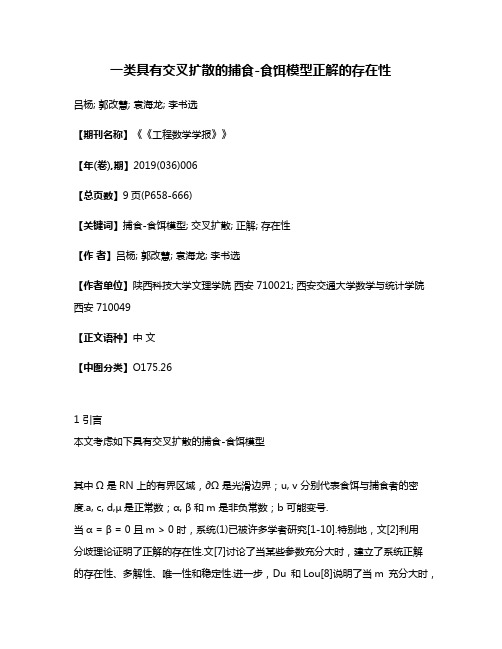
一类具有交叉扩散的捕食-食饵模型正解的存在性吕杨; 郭改慧; 袁海龙; 李书选【期刊名称】《《工程数学学报》》【年(卷),期】2019(036)006【总页数】9页(P658-666)【关键词】捕食-食饵模型; 交叉扩散; 正解; 存在性【作者】吕杨; 郭改慧; 袁海龙; 李书选【作者单位】陕西科技大学文理学院西安 710021; 西安交通大学数学与统计学院西安 710049【正文语种】中文【中图分类】O175.261 引言本文考虑如下具有交叉扩散的捕食-食饵模型其中Ω是RN 上的有界区域,∂Ω 是光滑边界;u, v 分别代表食饵与捕食者的密度.a, c, d,µ是正常数;α, β 和m 是非负常数;b 可能变号.当α = β = 0 且m > 0 时,系统(1)已被许多学者研究[1-10].特别地,文[2]利用分歧理论证明了正解的存在性.文[7]讨论了当某些参数充分大时,建立了系统正解的存在性、多解性、唯一性和稳定性.进一步,Du 和Lou[8]说明了当m 充分大时,奇异扰动系统存在Hopf 分歧,进而说明原系统存在Hopf 分歧.当α,β > 0 且m = 0 时,则系统(1)变成具有Lotka-Volterra 捕食-食饵模型,已经被许多生物数学家所探究[11-15].特别地,文[11]用分歧理论研究了正解的存在性,并证明共存区域随着β 增大而增大,随着α 增大而减小.进一步,文[14]讨论了当空间维数小于5 时,他们寻找到了一个与α, β 无关的先验估计.在文[16],Wang 和Li 利用分歧理论说明当b ∈(b∗,b∗),系统(1)至少有一个正解.特别地,当α 充分大时,他们以b 为分歧参数证明了全局分歧解在b = b∗从半平解(θa,0)出发连接到在b = (µ+1)λ1 的半平凡解(0,sϕ1),从而形成一个有界解,其中s>0. 本文主要讨论当交叉扩散系数α 充分大时正解的极限行为.特别地,我们以a 为分歧参数,利用全局分歧理论说明极限系统的正解将随着分歧参数a 在正锥内到达无穷.令λ1(p)<λ2(p)≤λ3(p)≤···是下列问题的特征值其中我们知道λ1(p)是简单的、实的,λ1(p)关于p 是严格单调递增的.当p ≡ 0 时,我们记λ1(0)为λ1.进一步,我们记ϕ1 是λ1 对应的特征函数且满足ϕ1 >0,||ϕ1||2 =1.我们知道当a>λ1 时,下列问题存在唯一的正解θa,且a →θa 在a ∈(λ1,+∞)是连续的,θa 关于a 是单调递增的.进一步,θa 非退化,线性稳定.2 预备知识则我们有系统(1)可以写成引理1 令(u,v)是系统(1)的任意正解,则存在一个与α 无关的常数C1,使得证明令(u,v)是系统(1)的任意正解,则根据比较原理,我们知道其中U∗是方程在Ω 上且满足U∗|∂Ω =0 的解.从而说明 u, U 存在与α 无关的先验估计.对于V 的方程,我们有同理,我们说明v, V 存在与α 无关的先验估计.定义下面的引理说明a∗(b)的一些性质.由于证明过程比较简单,我们在此略去其证明而仅陈述其结果.引理2[11] 集合S 形成一个有界的曲线其中a=a∗(b)是b ∈(0,(µ+1)λ1]的正的连续函数,且满足下面的性质:(i) a=a∗(b)关于b ∈ (0,(µ +1)λ1)是严格单调递减的;(ii) a∗((µ +1)λ1)= λ1.在此,我们定义ϕ∗>0 满足下面的方程对p>N,我们定义Banach 空间X 和Y 如下通过Sobolev 嵌入定理,我们知道3 主要结论在本节中,我们主要考虑当α 充分大时,极限系统正解的存在性.通过引理1 我们知道,系统(1)或(2)存在与α 无关的先验估计.下面的引理表明当α 充分大时,系统(1)的任意正解收敛到下述系统(4)的正解. 引理3[16] 存在充分大的Λ,使得当α ≥Λ,且α=αi 时,(ui,vi)是系统(1)的任意正解,则上成立,其中是下面系统的正解我们通过分歧理论建立系统(4)正解的存在性,而这只需建立下面系统(5)正解的存在性.我们通过分歧理论说明当a ∈(a∗,∞)时,系统(5)至少存在一个正解.令则系统(4)可以写成当a>λ1 时,系统(5)存在半平凡解我们以a 为分歧参数,利用局部和全局分歧理论来建立系统(5)正解的存在性.令其中是的函数.通过在处Taylor 展开,令则显然f(θa,0)=−∆θa, g(θa,0)=0.令则其中令K 是−∆在齐次Dirichlet 边界条件下的逆算子,则定义T :R×X →X则是X 空间上的紧算子.令显然H(a;0,0)=0,且记的Frchet 导数为下面,我们利用局部分歧理论说明系统(5)在(a∗;θa∗,0)附近存在局部分歧解.定理1 设a > λ1,则(a∗;θa∗,0) ∈ R × X 是系统 (5)的分歧点,且存在δ > 0,在分歧点(θa,0)的邻域内存在如下形式的正解其中是光滑函数且满足证明令则令则如果矛盾.因此a=a∗, ker L1(a∗;0,0)=span{ψ∗,ϕ∗},其中我们定义算子L1(a∗;0,0)的伴随算子为令则根据Fredholm 选择公理,我们知算子L1(a∗;0,0)的值域为因此R(L1(a∗;0,0))的余维数是1.为了在处应用局部分歧理论[17],我们断言显然我们采用反证法.假设存在满足也就是在上面的等式两边同乘以ϕ∗,再积分,我们有矛盾.根据全局分歧理论,我们断言局部分歧解可以延拓为全局分歧解,并且该全局分歧解随着分歧参数a 在正锥内延伸到无穷.令假设σ ≥ 1 是算子T′(a)的特征值且其对应的特征函数为(ξ,η),则则σ ≥ 1 是算子T′(a)的特征值的充要条件是:存在一些i = 1,2,···,使得a = ai(µ).进而,若a<a∗,则i(T(a,·),0)=1,如果a∗ <a<a2(1),则i(T(a,·),0)= −1.根据全局分歧理论[18],我们知道在R+×X 内,存在从(a∗;0,0)出发的连通分支C0,满足H(a;ξ,η) = 0,且在(a∗;0,0)附近,H(a;ξ,η)的所有零点都在定理1 中得到的那条分歧曲线令则C 是系统(5)从(a∗;0,0)分歧的解曲线,令在(a∗;θa∗,0)的小邻域内,解曲线C ⊂ P0.定理2 C −{(a∗;θa∗,0)}在正锥内随着分歧参数a 延伸到无穷.证明根据Rabinowitz 全局分歧理论[18]和更加一般的分歧理论[19,20],我们断言全局分歧解C −{(a∗;θa∗,0)}必满足下列三个选择之一:(i) 全局分歧解C 连接半平凡解{a;θa,0},其中 aa∗且I − T′(a)是不可逆的;(ii) 全局分歧解C 在R×X 是无界的;(iii) 存在a = 和W ∈\{0},满足(;W) ∈C,其中是空间{(0,−∆ϕ∗)}的补空间,{(0,−∆ϕ∗)}由定理1 给出.如果则存在使得在Ω 的极限.由于由最大值原理我们知道,在Ω.假设令则根据二阶椭圆型方程的正则化理论,我们假设在C1 上成立且满足和在Lp 弱收敛.在上面系统的两边同时取极限,我们有根据最大值原理我们知道,>0 在Ω 上成立.因此由a∗的定义我们知道,有=a∗,矛盾.假设类似地,我们可以得到矛盾.因此,我们说明C −{(a∗;θa∗,0)} ⊂ P0.进而(i)不可能发生.由于在Ω 上ϕ∗>0,补空间不可能包含不变号的元素,从而(iii)也不可能发生.由Lp 估计和Sobolev 嵌入定理,我们知道存在正常数,使得因此,全局分歧解C 只能随着分歧参数a 在正锥内到达无穷.参考文献:【相关文献】[1]袁海龙,李艳玲.一类捕食-食饵模型共存解的存在性与稳定性[J].陕西师范大学学报(自然科学版),2014, 42(1):15-18 Yuan H L, Li Y L.Coexistence of existence and stability of a predator-prey model[J].Journal of Shaanxi Normal University (Natural Science Edition), 2014, 42(1): 15-18[2]Blat J, Brown K J.Global bifurcation of positive solutions in some systems of elliptic equations[J].SIAM Journal on Mathematical Analysis, 1986, 17(6): 1339-1353[3]Brown K J.Nontrivial solutions of predator-prey systems with smalldiffusion[J].Nonlinear Analysis:Theory Methods & Applications, 1987, 11(6): 685-689[4]Casal A, Eilbeck J C, Lpez-Gmez J.Existence and uniqueness of coexistence states for a predator-prey model with diffusion[J].Differential & Integral Equations, 1994, 7(2): 411-439[5]Conway E D, Gardner R, Smoller J.Stability and bifurcation of steady-state solutions for predator-prey equations[J].Advances in Applied Mathematics, 1982, 3(3): 288-334[6]Dancer E N.On positive solutions of some pairs of differential equations[J].Transactions of the American Mathematical Society, 1984, 284(2): 729-743[7]Du Y, Lou Y.Some uniqueness and exact multiplicity results for a predator-preymodel[J].Transactions of the American Mathematical Society, 1997, 346(6): 2443-2475 [8]Du Y,Lou Y.S-shaped global bifurcation curve and Hopf bifurcation of positive solutions to a predator-prey model[J].Journal of Differential Equations, 1998, 144(2): 390-440[9]Du Y, Shi J.A diffusive predator-prey model with a protection zone[J].Journal of Differential Equations,2006, 229(1): 63-91[10]Du Y, Peng R, Wang M.Effect of a protection zone in the diffusive Leslie predator-prey model[J].Journal of Differential Equations, 2009, 246(10): 3932-3956[11]Kadota T,Kuto K.Positive steady states for a prey-predator model with some nonlinear diffusion terms[J].Journal of Mathematical Analysis & Applications, 2006, 323(2): 1387-1401[12]Kuto K, Yamada Y.Multiple coexistence states for a prey-predator system with cross-diffusion[J].Journal of Differential Equations, 2004, 197(2): 315-348[13]Kuto K.A strongly coupled diffusion effect on the stationary solution set of a prey-predator model[J].Advances in Differential Equations, 2007, 12(2): 145-172[14]Kuto K, Yamada Y.Coexistence problem for a prey-predator model with density-dependent diffusion[J].Nonlinear Analysis, 2009, 71(12): e2223-e2232[15]Nakashima K, Yamada Y.Positive steady states for prey-predator models with cross-diffusion[J].Advances in Differential Equations, 1996, 1(6): 1099-1122[16]Wang Y X, Li W T.Stationary problem of a predator-prey system with nonlinear diffusion effects[J].Computers & Mathematics with Applications, 2015, 70(8): 2102-2124 [17]Crandall M G, Rabinowitz P H.Bifurcation from simple eigenvalues[J].Journal of Functional Analysis,1971, 8(2): 321-340[18]Rabinowitz P H.Some global results for nonlinear eigenvalue problems[J].Journal of Functional Analysis,1971, 7(3): 487-513[19]Lpez-Gmez J.Spectral Theory and Nonlinear Function Analysis[M].Boca Raton: Chapman and Hall/CRC, 2001[20]Dancer E N.Bifurcation from simple eigenvalues and eigenvalues of geometric multiplicity one[J].Bulletin of the London Mathematical Society, 2002, 34(5): 533-538。
EXISTENCE AND MULTIPLICITY OF SOLUTIONS TO A CLASS OF DIRICHLET PROBLEMS WITH IMPULSIVE EFFECTS
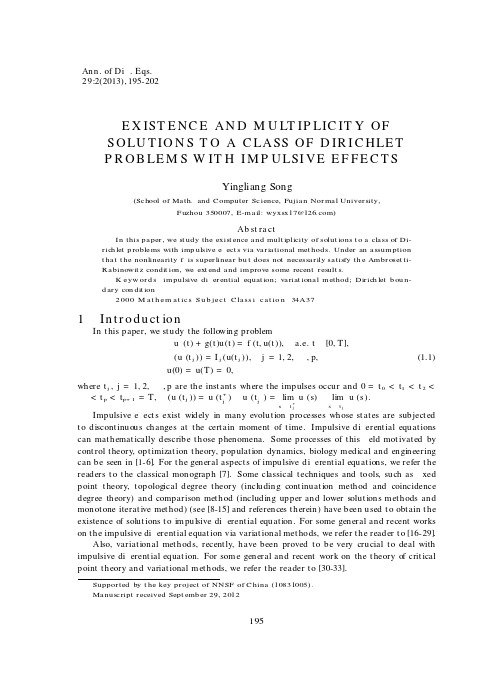
E X IST E NC E AN D M U LT IP LIC IT Y OF S OLU T IO N S T O A C LASS OF D IR I C HLE T P R OB LE M S W IT H I M P ULSI VE E F F E C T SYingliang Song(Sc hool of Ma th.and C omputer Sc ience,Fujia n Nor ma l Univer sity,F uzhou 350007,E-m a il:wyxsx17@)Ann.of Di .Eqs.29:2(2013),195-202Ab st ra ctI n this pa per ,we st udy the exist ence a nd mult iplicity of solut ions t o a cla ss of Di-r ic h let p roble ms with imp ulsive e ect s via va r ia tional met hods.Under an a ssum ption t ha t t he nonlinea rity f is super linea r bu t does not necessa r ily sa tisfy th e Am br oset ti-R a binowit z condit ion,we ext end a nd im prove some recent r esult s.K e yw or d s im pulsive di er ential equat ion;va riat iona l m ethod;Dir ic h let b ou n-d ar y con dit ion2000M a t h e m a t ic s S u b je c t C la ss i c a t io n 34A371In t r o d u ct io nIn t his paper,we st udy t he following problemu ′′(t )+g(t )u(t )=f (t,u(t )),a.e.t ∈[0,T],(u ′(t j ))=I j (u(t j )),j =1,2,,p,u(0)=u(T)=0,(1.1)where t j ,j =1,2,,p are the inst ant s where t he impulses occur and 0=t 0<t 1<t 2<<t p <t p+1=T,(u ′(t j ))=u ′(t +j )u ′(t j )=lim s →t +ju ′(s)lim s →t ju ′(s ).Impulsive e ect s exist widely in many evolut ion processes whose st at es are subject ed t o discont inuous changes at t he cert ain moment of t ime.Impulsive di erent ial equat ions can mat hemat ically describe t hose phenomena.Some processes of t his eld mot ivat ed by cont rol t heory,opt imizat ion t heory,populat ion dynamics,biology m edical and engineering can be seen in [1-6].For t he general aspect s of impulsive di erent ial equat ions,we refer t he readers t o t he classical monograph [7].Some classical t echniques and tools,such as xed point t heory,t opological degree t heory (including cont inuat ion method and coincidence degree theory)and comparison met hod (including upper and lower solut ions m et hods and monot one iterat ive met hod)(see [8-15]and references t herein)have been used t o obt ain t he existence of solut ions t o im pulsive di erent ial equat ion.For some general and recent works on t he impulsive di erent ial equat ion via variat ional met hods,we refer t he reader t o [16-29].Also,variat ional met hods,recent ly,have been proved t o be very crucial t o deal with impulsive di erent ial equat ion.For som e general and recent work on the t heory of crit ical point t heory and variat ional m et hods,we refer t he reader t o [30-33].Suppor ted by t he key pr oject of NNSF of C hina (10831005).Ma nusc ript r eceived Sept emb er 29,2012195196ANN.OF DIF F.E QS.Vol.29More precisely,in [16],t he aut hors used t he variat ional met hod t o obt ain the mult iplicit y of solut ions to problem (1.1).Brie y,Zhang [17],Liu [18]and Chen [19]ext ended t he result s of [16]using some new crit ical point pared wit h [16],t hey did not assume t hat t he nonlinearit y f sat is es t he Ambroset t i-Rabinowitz condit ion,t hat is,t here exist >2and R >0such t hat0<F (t ,u)≤uf (t,u),u ∈R \{0}and for all t ∈[0,T],or0<F (t,u)≤uf (t ,u),|u|>R and for all t ∈[0,T].Mot ivat ed by t he above fact ,in t his paper,our aim is also t o st udy problem (1.1)under t he case t hat t he nonlinearit y f is superlinear which was not considered in [16-29].In t his paper,we do not require t hat F (t ,u)>0,for u ∈R \{0}and f (t,u)=o(|u|),as u →0,or 0≤F (t,u)=o(|u|2),as u →0.We use variat ional met hods t o get t he exist ence and mult iplicit y of solut ions t o problem (1.1),which ext ends t he exist ing result s.In t his paper,we always assume that λ=π2/T 2is t he rst eigenvalue of t he problem {u ′′(t)=λt ,in [0,T],u(0)=u(T)=0,(f)f :[0,T]×R →R is cont inuous,f (t ,s )=f 1(t ,s )f 2(t ,s );(g)g ∈L ∞[0,T],and essinf t ∈[0,T ]g(t)=m >λ1;(i)I j :R →R,j =1,2,,p,are cont inuous,F (t,u)=∫uf (t ,s )ds,F 1(t ,u)=∫uf 1(t ,s )ds ,F 2(t ,u)=∫uf 2(t ,s )ds.Now we st at e t he assum pt ions:(H 1)f 1(t ,u)and f 2(t,u)are cont inuous;(H 2)t here exist s a >2,such t hat 0<F 1(t,u)≤uf 1(t,u),u ∈R \{0};(H 3)t here exist s an 1<α<2,such t hat 0<uf 2(t ,u)≤αF 2(t ,u),u ∈R \{0};(H 4)t here exist s a 0<β<,such t hat 0<uI j (u)≤β∫u0I j (s )ds ,u ∈R \{0},j =1,2,,p;(H 5)I j (u)are odd about u,j =1,2,,p;(H 6)f (t,u)is odd about u.Now we st at e our m ain result s.T he or em 1.1Suppose that (H 1),(H 2),(H 3)and (H 4)hold,t hen problem (1.1)has a t least one solution.T he or em 1.2Suppose that (H 1),(H 2),(H 3),(H 4),(H 5)and (H 6)hold,then problem (1.1)has in nitely many solutions.R em a r k (H 2)and (H 3)can guarantee t hat f is superlinear,but does not necessarily sat isfy F (t,u)>0,for u ∈R \{0}and f (t ,u)=o(|u|),as u →0,or 0≤F (t,u)=o(|u|2),as u →0.So f does not sat isfy t he Ambroset t i-Rabinowitz condit ion,which is considered in t he rst t im e.2P r elim in ar iesIn t his sect ion,we rst int roduce som e t heorems which are necessary.Suppose that ENo.2Y.L.Song,SOLUT IONS TO IMPULSIVE E QUATION 197is a Banach space and φ∈C 1(E ,R ).We say t hat φsat is es t he P.S.condit ion,t hat is,every sequence {u j }E sat isfying t hat {φ(u j )}is bounded and lim j →∞φ′(u j )=0cont ains aconvergent subsequence.T he or em 2.1[30](Mountain P ass Theorem)Let E be a real Ba nach space and I ∈C 1(E ,R )sa tis es the P.S.condit ion with I (0)=0.If I sat is es the following condit ions :(1)T here exist consta nts ρ,α>0such that I |B ρ≥α;(2)t here exis ts an e ∈E \B ρ,such that I (e)≤0.Then I possesses a crit ical value c ≥α.Moreover,c is given by c =inf g ∈Γmax s ∈[0,1]I (g(s)),whereΓ={g ∈C ([0,1],E )|g(0)=0,g(1)=e}.T he or em 2.2[30](Symmetric Mount ain P ass T heorem)L et E be a real Banach space and I ∈C 1(E,R )be even,sat isfying t he P.S.condit ion w it h I (0)=0.Let E =V ⊕Y,where Vis nit e dimensional,and φsatis es the follow ing conditions:(1)T here exist consta nts ρ,α>0such that I |B ρ∩Y ≥α;(2)for each nite dimensional subspace W E ,there is an R =R (W )such t hat φ(u)≤0for all u ∈W with ∥u ∥>R.Then φhas a unbounded crit ical values.The space H 10(0,T)is equipped wit h t he inner product u,v =∫Tu ′(t)v ′(t)dt,and with t he associat ed norm∥u ∥H 10(0,T )=(∫T(u ′(t ))2dt)12.We also use the inner productu,v =∫Tu ′(t )v ′(t )dt +∫Tg(t )u(t )v(t)dt,and the norm∥u ∥=(∫T(u ′(t))2dt +∫Tg(t)(u(t))2dt)12.Taking v ∈H 10(0,T)and mult iplying (1.1)by v,we have∫T 0u ′′v +∫T 0guv =∫Tf (t ,u)v.The rst t erm in t he left of the above equality is ∫T 0u ′′v =p ∑j =0∫t j +1t ju ′′v,and∫t j +1t ju ′′v =u ′(t j +1)v(t j +1)u ′(t +j )v(t +j )∫t j +1t j u ′v ′.Hence∫Tu ′′v =p∑j =0u ′(t j )v(t j )+u ′(0)v(0)u ′(T)v(T )+∫Tu ′v ′=p ∑j =1I j (u(t j ))v(t j )+∫Tu ′v ′.198ANN.OF DIF F.E QS.Vol.29A weak solut ion t o (1.1)is a funct ion u ∈H 10(0,T )such t hat ∫T 0u ′(t)v ′(t)dt +∫T 0g(t)u(t)v(t )dt =∫Tf (t,u(t ))v(t)dtp∑j =1I j (u(t j ))v(t j ),for every v ∈H 10(0,T).For each u ∈H 10(0,T),we de ne φon H 10(0,T)byφ(u)=12∥u ∥2∫T 0F (t,u(t ))dt +p ∑j =1∫u (t j )I j (s )ds ,(2.1)where F (t ,u)=∫u0f (t,s)ds.Since f 1,f 2and I j ,j =1,2,,p are cont inuous,one can easily verify φ∈C 1(H 10,R ).For any v ∈H 10(0,T),we haveφ′(u),v =∫T 0u ′(t)v ′(t )dt +∫T 0g(t)u(t)v(t )dt ∫T 0f (t,u(t ))v(t)dt +p∑j =1I j (u(t j ))v(t j ).(2.2)Thus,t he weak solut ions t o problem (1.1)are t he corresponding crit ical point s of φ.3P r o ofs of T h eor em sLem m a 3.1[21]Suppose t hat (H 2)holds,then for every t ∈[0,T],t he following inequa-lities hold F (t,u)≤F (t ,u|u|)|u|,0<|u|≤1,(3.1)F (t,x)≥F (t ,u |u|)|u|,|u|≥1.(3.2)From t he above fact ,we can easily get t he following t hree lemm as.Lem m a 3.2Suppose that (H 2)holds,thenF 1(t,u)≤M 1|u|,0<|u|≤1,(3.3)F 1(t,u)≥m 1|u|,|u|≥1,(3.4)where M 1=maxt ∈[0,T ],|u |=1F 1(t,u),m 1=mint ∈[0,T ],|u |=1F 1(t ,u).Lem m a 3.3Suppose that (H 3)holds,thenF 2(t ,u)≥m 2|u|α,0<|u|≤1,(3.5)F 2(t ,u)≤M 2|u|α,|u|≥1,(3.6)where M 2=maxt ∈[0,T ],|u |=1F 2(t,u),m 2=mint ∈[0,T ],|u |=1F 2(t ,u).Lem m a 3.4Suppose that (H 4)holds,thenI j (u)≥m I j |u|β,0<|u|≤1,(3.7)I j (u)≤M I j |u|β,|u|≥1,(3.8)where M I j =m ax |u |=1I j (u),m I j =min |u |=1I j (u),j =1,2,,p.Lem m a 3.5[16]If essinf t ∈[0,T ]g(t )=m >λ1,then the norms ∥∥and ∥∥H 10(0,T )a re equivalent.No.2Y.L.Song,SOLUT IONS TO IMPULSIVE E QUATION199Lem m a 3.6[33]There exists a const ant C(depending only on|I|≤∞)such that ∥u∥L∞≤C∥u∥W1,p(I),for any u∈W1,p(I),1≤p≤∞.In other words,W1,p(I)L∞(I),w i th continuous injection for all1≤p≤∞.Further, if I is bounded then:t he injection W1,p(I)C(I)is compa ct for all1<p≤∞;and the injection W1,p(I)L q(I)is compact for all1≤p<∞.From Lemm a3.6,t here exists a C0≥0such that∥u∥L∞≤C0∥u∥,for any u∈H1(0,T),(3.9)where∥u∥L∞=ess sup{|u|:t∈[0,T]}.Lem m a 3.7If(H1),(H2),(H3)and(H4)hold,t henφsatis es the P.S.condition.P r oof Let{u n}be a sequence in H10(0,T)such t hat{φ(u n)}is bounded andφ′(u n)→0,as n→∞.F irst,we prove t hat{u n}is bounded.By(2.1)and(2.2),one hasφ(u n)φ′(u n)u n=(21)∥u n∥2+∫Tf1(t,u n)u n dt∫TF1(t,u n)dt∫Tf2(t,u n)u n dt +∫TF2(t,u n)dt+p∑j=1∫u n(t j)I j(s)dsp∑j=1u n(t j)I j(u n(t j)).By(H2),(H3)and(H4),we can deduce t hat∫T0f1(t,u n)u j dt∫TF1(t,u n)dt≥0,(3.10)∫T0F2(t,u n)dt∫Tf2(t,u n)u n dt≥0,(3.11)p ∑j=1∫u n(t j)I j(s)dsp∑j=1u n(t j)I j(u n(t j))≥0.(3.12)By(3.10),(3.11)and(3.12),we conclude t hatφ(u n)φ′(u n)u n≥(21)∥u n∥2.Since>2,it follows t hat{u n}is bounded in H1(0,T).Therefore t here exist s a subsequence also denot ed by u n∈H1(0,T)such t hatu n u,in H1(0,T),u n→u,in C([0,T],R),as n→∞.Henceφ′(u n)φ′(u),u n u→0,∫T 0(f(t,u n)f(t,u))(u n u)dt→0,p ∑j=1(u n(t j)I j(u n(t j)u(t j)I j(u(t j)))(u n(t j)u(t j))→0,as n→∞.Moreover,an easy comput at ion shows t hat200ANN.OF DIF F.E QS.Vol.29φ′(u n)φ′(u),u n u=∥u n u∥2∫T0(f(t,u n)f(t,u))(u n u)dt+p∑j=1(u n(t j)I j(u n(t j))u(t j)I j(u(t j)))(u n(t j)u(t j)).So∥u n u∥→0,as n→∞.That is,{u n}converges st rongly t o u in H10(0,T). Therefore,φsat is es t he P.S.condit ion.P r oof of T he or em 1.1Since f1,f2and I j,j=1,2,,p are cont inuous,we obt ain t hatφ∈C1(H10(0,T),R),φ(0)=0.By Lemm a3.7,φsat is es t he P.S.condit ion.It is clear t hat∥u∥≤1/C0,where C0is de ned in(3.9),implies∥u∥∞≤1.According t o Lemmas3.2and3.3,by(3.9),one has∫T0F1(t,u)dt≤∫TM1|u|dt≤M1TC∥u∥,(3.13)∫T0F2(t,u)dt≥∫Tm2|u|αdt≥m2T Cα0∥u∥α.(3.14)Combining(3.13),(3.14),(H4)and(3.9),one hasφ(u)≥12∥u∥2M1TC∥u∥+m2TCα∥u∥α≥12∥u∥2M1TC∥u∥.Since>2,one can choose aρ>0sm all enough such t hatφ(u)≥0.Finally,it remains t o show t hat t here exist s an e such t hat∥e∥>ρandφ(e)≤0.In fact,by(2.1),(3.4),(3.6)and(3.9),for everyξ∈R\{0},u∈H10(0,T)\{0}wit h ∥ξu∥∞≥1w e have t he following inequalit yφ(ξu)=12∥u∥2ξ2∫TF1(t,ξu(t))dt+∫TF2(t,ξu(t))dt+p∑j=1∫ξu(tj)I j(s)ds≤12∥u∥2ξ2m1TC∥u∥ξ+M2TCα∥u∥αξα+p∑j=1M IjCβ∥u∥βξβ.Since>2,1<α<2and0<β<,(3.6)im plies that t here exist s aξ∈R\{0}such t hat∥ξu∥>ρandφ(ξu)≤0,so we set e:=ξu.By Theorem2.1,φhas a crit ical value. Consequently,we obt ain a weak solut ion.P r oof of T heor em 1.2f1,f2and I j are odd funct ions which implies t hatφis even. Moreover,by t he assumptions of Theorem1.2,φ∈C1(H10(0,T),R)wit hφ(0)=0sat is es t he P.S.condit ion.To apply Sym met ric M ount ain Pass Theorem,it su ces t o prove t hatφsat is es condi-t ions(1)and(2)of Theorem2.2.First ly one can easily verify(1)similar t o t hat in t he proof of Theorem1.1.It rem ains t o prove t hat,for each nit e dimensional subspace W H1(0,T),t here is an R=R(W) such t hatφ(u)≤0for all u∈W wit h∥u∥>R.By(3.8),t here exist s a constant C1for everyξ∈R\{0},u∈W\{0}wit h∥ξu∥∞≥1such t hatp∑j=1∫ξu(tj)I j(s)ds≤C1p∑j=1M Ij∥u∥βξβ.(3.15)No.2Y.L.Song,SOLUT IONS TO IMPULSIVE E QUATION201By(3.4),(3.6),t here exist constant s C2and C3for everyξ∈R\{0},u∈W\{0}with ∥ξu∥∞≥1such t hat∫T0F1(t,ξu(t))dt≥C2m1T∥u∥ξ,(3.16)∫TF2(t,ξu(t))dt≤C3M2T∥u∥αξα.(3.17) Combining(2.1),(3.16),(3.17)and(3.15),one hasφ(ξu)=12∥u∥2ξ2∫TF1(t,ξu(t))dt+∫TF2(t,ξu(t))dt+p∑j=1∫ξu(tj)I j(s)ds≤12∥u∥2ξ2C2m1T∥u∥ξ+C3M2T∥u∥αξα+C1p∑j=1M Ij∥u∥βξβ.Since>2,1<α<2and0<β<,t here is aξ∈R\{0}such t hat∥ξu∥>ρand φ(ξu)≤0,so we set e:=ξu.By T heorem2.2,t he funct ionalφpossesses in nit ely m any crit ical point s,t hat is,t he im pulsive problem(1.1)has in nit ely many weak solut ions.4E xam p leIn t his sect ion,we give an example t o illust rat e our result s.E xam ple4.1Consider t he following problem:u′′(t)+(t2+2)u(t)=f(t,u(t)), a.e.in[0,π],(u′(t j))=I j(u(t j)),j=1,2,,p,u(0)=u(π)=0,(4.1)where f(t,u(t))=u5u1/3,I j(u(t j))=u3.Com paring problem(4.1)wit h(1.1),let f1(t,u(t))=u5and f2(t,u(t))=u1/3.Then,it is easy t o verify t hat all condit ions of Theorem2.2are sat is ed.By T heorem2.2,problem (4.1)has in nit ely many solut ions.R efer en ces[1]R.K.Geor ge, A.K.Na ndakum a ra n, A.Ar ap ost at his,A not e on cont rolla bility of impu lsivesyst ems,J.Ma th.Ana l.Appl.,241(2000),276-283.[2]S.Nen ov,I mpulsive cont r olla bility and opt im iz at ion pr oblem s in popula t ion dynam ics,Non li-nea r An al.,36(1999),881-890.[3]G.Jia ng,Q.Lu,Im pulsive st at e feedba ck cont rol of a pr eda tor-pre y m odel,J.C om put.Appl.Ma th.,200(2007),193-207.[4]M.C hoisy,J.F.Gu ega n,P.R oha ni,Dyna m ics of infect ious d iseases an d pulse vaccina tion:t easin g a pa rt th e emb edded r esona nce e ect s,P hysica D,223(2006),26-35.[5] A.D’Onof r io,On p ulse va ccina t ion st ra t egy in t he SIR e pidem ic m odel with vert ic al t r ans-m ission,Appl.Ma th.Let t.,18(2005).729-732.[6]S.Ga o,L.Che n,J.J.Nieto, A.Torr es,Ana lysis of a delayed epide mic m odel wit h p ulseva ccinat ion a nd sa tur at ion incidence,Va c c ine,24(2006),6037-6045.[7]kshm ikant ham,D.D.B ainov,P.S.Simeonov,Theor y of Im pulsive Di e rent ia l Equa t ions,in:Se ries M oder n Appl.M at h.,Vol.6,World Scienti c,Te aneck,NJ,1989.[8] D.Fr anco,J.J.Niet o,Non linea r b ound ar y va lue problem s for rst or der im pulsive funct ionaldi er ential equa tions, put.Appl.Ma th.,88(1998),149-159.202ANN.OF DIF F.E QS.Vol.29 [9]X.Lin,D.J ian g,Mult iple p osit ive solut ions of Dir ichlet bounda ry value pr oblem s for secondor der im pulsive di er ential equa tion s,J.Ma th.Ana l.Appl.,321(2006),501-514.[10]X.Yan g,J.Sh en,Nonlinea r bounda ry va lue pr oblem s for r st or der imp ulsive f u nctionaldi er ential equa tions,Appl.M ath.C omput.,189(2007),1943-1952.[11]J.J.Niet o,B asic theor y f or nonresonanc e im pulsive per iodic pr oblem s of rst or der,J.M ath.An al.Appl.,205(1997),423-433.[12]J.J.Niet o,P eriodic bounda ry va lue problems for r st-or der imp ulsive or dina r y di er entialequat ions,Nonline a r Ana l.T MA,51(2002),1223-1232.[13] B.Ahm a d,J.J.Nieto,E xistenc e a nd app roxim at ion of solu tions f or a c la ss of nonlinear im-pulsive func tiona l d i e rent ia l equa t ions with a nti-per bounda ry conditions,Nonlinear Ana l.TM A,69(2008),3291-3298.[14]X.Ya ng,J.Shen,P eriodic bou ndar y va lu e problems for second-or der im pulsive int egro-di er ential equa tions,put.Appl.Ma th.,209(2007),176-186.[15]J.Yan,A.Zha o,J.J.Nieto,Exist ence and global a tt r act ivity of p osit ive per iodic solut ion ofper iodic single-spe cies im pulsive Lotka-Volter ra syste m,Mat h.C om put.M ode l.,40(2004),509-518.[16]J.Zhou,Y.Li,Exist ence a nd m ult iplicity of solut ions for som e D ir ichlet pr oblem s wit h im-pulsive e ect s,Nonlinea r An al.TM A,71(2009),2856-2865.[17]Dan Zha ng,Binxia ng Dai,In nit ely m a ny solut ions for a c la ss of nonlinea r impu lsive di er en-tia l e qua t ions wit h p eriodic bounda ry c ondit ions,C omput.Ma th.Appl.,61(2011),3153-3160.[18]Zh isu Liu,Haibo C hen and T iejun Zhou,Var ia t ional m et hods to t he second-or der im pul-sive di ere nt ial equat ion wit h Dirichlet bounda ry value pr oblem,Ma th.C omput.Model., 61(2011),1154-1161.[19]P.C hen,X.H.Tang,New exist ence a nd m ultiplicity of solut ions for som e Dirich-let pr oblem with im pulsive e ect s,Ma thema tical a nd Com pute r Mode lling,(2011).doi:10.1016/j.m cm.2011.08.046[20] D.Zha ng, B.Da i,Exist ence of solut ions for non linea r impu lsive di er ential equa tions wit hDir ic h let bounda ry conditions,Ma put.M odel.,53(2011),1687-1690.[21]Z.Zha ng,R.Yuan,An a pplica tion of va r ia tional m et hods to Dir ichlet bounda r y va lu e pr ob lemwit h im pulse s,Non linear Ana l.RWA,11(2010),155-162.[22]J.J.Niet o, D.O’R ega n,Va r ia tional appr oach to im pulsive di er ent ia l equa tions,Nonlin e a rAn al.RWA,10(2009),680-690.[23]J.Sun,H.C hen,Multiplicity of solu tions for a class of im pulsive d i erent ia l equat ionswit h Dir ichlet bounda r y condition s via va riant founta in t heore ms,Nonlin e a r An al.RWA, 11(2010),4062-4071.[24]H.Zha ng,Z.Li,Va ria tiona l app roach to impu lsive di er ent ia l e qu at ions wit h pe riodic boun-da ry conditions,Nonlinear Ana l.RWA,11(2010),67-78.[25]Y.Tia n,W.Ge,Var iat iona l met hods t o St urm-Liouville b ound ar y va lue pr oblem for im pulsivedi er ential equa tions,Nonlinear Ana l.T MA,72(2010),277-287.[26]J.Sun,H.C hen,L.Yan g,T he exist ence and m ult ip licit y of solut ions for an imp ulsive di er en-tia l equa tion wit h two pa ra m ete rs via va r ia tion al me thod,Nonlinea r An al.TM A,73(2010),440-449.[27]Y.T ia n,W.G.Ge,Var ia t ional met hods t o St ur m-Liou ville bounda ry va lue pr oblem for im-pulsive di erent ia l equat ions,Nonlin e a r Ana l.,72(2010),277-287.[28]J.Xiao,J.J.Niet o,Va riat iona l appr oach t o som e da mp ed Dirichlet nonlinea r im pulsive di e-re nt ial equat ions,J.Fra nklin I nst.,348(2011),369-377.[29]Y.T ia n,W.G.G e,Applicat ions of va r ia tional me thods to bounda r y value pr oblem for im pul-sive di er ent ial equa tions,P roc.Edinb.Ma th.Soc.,51(2008),509-527.[30]P.H.R a binowitz,Minima x Met hods in Cr itical P oint T heory wit h Applica tions to Di er entialEqua tion s,C.B.M.S.65,Am er.Ma th.Soc.,P rovidenc e,R.I.,1985.[31]M.St ruwe,Va r ia tion al Met hods,Sp ringe r-Ver lag,1990.[32] E.Zeidler,T he Ljust ern ik-Schnirem a n th eor y for in de nite a nd not n ecessa rily odd n onlin earop era t or s and it s a pplica t ions,Nonlinea r Anal.TM A,4(1980),451-489.[33]H.Br ezis,Funct iona l Ana lysis,Sobolev Spa ces a nd P a rt ia l Di er entia l Equa tions,S pringer,2010.(edited by Liangwei Huang)。
(n-1,1)-型分数阶共轭边值问题的正解
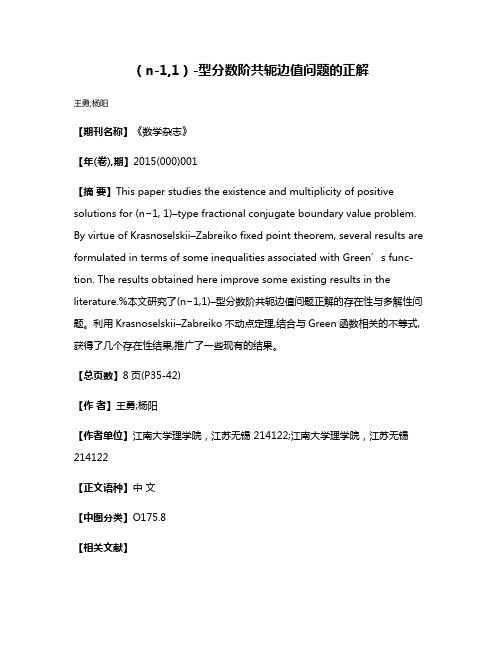
(n-1,1)-型分数阶共轭边值问题的正解王勇;杨阳【期刊名称】《数学杂志》【年(卷),期】2015(000)001【摘要】This paper studies the existence and multiplicity of positive solutions for (n−1, 1)–type fractional conjugate boundary value problem. By virtue of Krasnoselskii–Zabreiko fixed point theorem, several results are formulated in terms of some inequalities associated with Green’s func-tion. The results obtained here improve some existing results in the literature.%本文研究了(n−1,1)–型分数阶共轭边值问题正解的存在性与多解性问题。
利用Krasnoselskii–Zabreiko不动点定理,结合与Green函数相关的不等式,获得了几个存在性结果,推广了一些现有的结果。
【总页数】8页(P35-42)【作者】王勇;杨阳【作者单位】江南大学理学院,江苏无锡 214122;江南大学理学院,江苏无锡214122【正文语种】中文【中图分类】O175.8【相关文献】1.一类(n-1,1)共轭型边值问题的正解存在性 [J], 马永梅;谭春晓2.一类分数阶共轭边值问题正解的存在唯一性 [J], 郑凤霞;文武;谢茂森3.具有适型分数阶导数的边值问题的正解 [J], 董晓玉;白占兵;孙苏菁4.一类具有适型分数阶导数的分数阶微分方程m点边值问题的正解 [J], 赵微5.依赖于一阶导数的(n-1,1)共轭m点边值问题正解的存在性 [J], 纪玉德;郭彦平;禹长龙因版权原因,仅展示原文概要,查看原文内容请购买。
Existence and uniqueness results for fractional differential equations with uncertainty
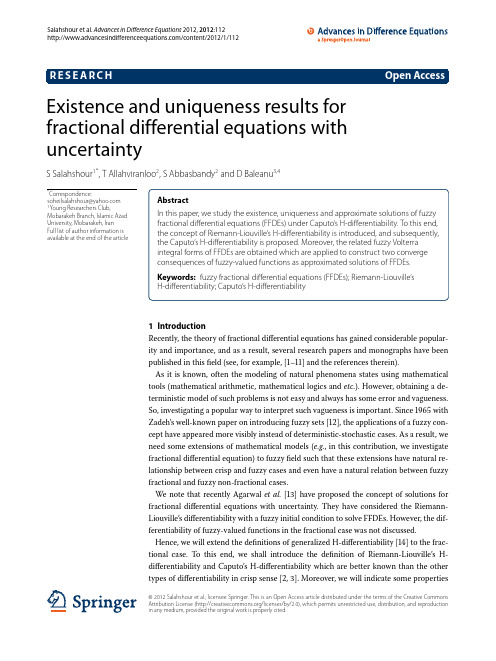
Salahshour et al. Advances in Difference Equations 2012, 2012:112 /content/2012/1/112
RESEARCH
Open Access
Existence and uniqueness results for fractional differential equations with uncertainty
S Salahshour1* , T Allahviranloo2 , S Abbasbandy2 and D Baleanu3,4
Correspondence: soheilsalahshour@ 1 Young Researchers Club, Mobarakeh Branch, Islamic Azad University, Mobarakeh, Iran Full list of author information is available at the end of the article
1 Introduction Recently, the theory of fractional differential equations has gained considerable popularity and importance, and as a result, several research papers and monographs have been published in this field (see, for example, [–] and the references therein). As it is known, often the modeling of natural phenomena states using mathematical tools (mathematical arithmetic, mathematical logics and etc.). However, obtaining a deterministic model of such problems is not easy and always has some error and vagueness. So, investigating a popular way to interpret such vagueness is important. Since with Zadeh’s well-known paper on introducing fuzzy sets [], the applications of a fuzzy concept have appeared more visibly instead of deterministic-stochastic cases. As a result, we need some extensions of mathematical models (e.g., in this contribution, we investigate fractional differential equation) to fuzzy field such that these extensions have natural relationship between crisp and fuzzy cases and even have a natural relation between fuzzy fractional and fuzzy non-fractional cases. We note that recently Agarwal et al. [] have proposed the concept of solutions for fractional differential equations with uncertainty. They have considered the RiemannLiouville’s differentiability with a fuzzy initial condition to solve FFDEs. However, the differentiability of fuzzy-valued functions in the fractional case was not discussed. Hence, we will extend the definitions of generalized H-differentiability [] to the fractional case. To this end, we shall introduce the definition of Riemann-Liouville’s Hdifferentiability and Caputo’s H-differentiability which are better known than the other types of differentiability in crisp sense [, ]. Moreover, we will indicate some properties
pohozaev流形方法的开题报告

假设 ,且 是 的临界点的一个必要条件是
这个条件定义了一个Nehari流形
Euler函数
首先找出方程的Nehari流形,定义Euler函数,讨论关于函数的一些引理,结合(PS)条件,山路引理和Sobolev嵌入定理确定合适的 ,使得 ,方程至少存在两个正解。
研究的意义:
方程在当今科学研究领域中扮演着重要的角色.近年来,很多源于物理学,工程学等科学领域,具有实际应用背景的微分方程边值问题引起了人们的极大兴趣.众多作者综合运用变分法,山路引理,临界点理论等多种方法分析研究方程解的存在性与多重性.方程在物理、化学、生物、金融数学等不同的学科领域已得到广泛的应用。具N-Laplace算子的微分方程边值问题也早已运用到工程、物理学等领域,随着分数阶微分方程在实际生产和生活中的不断应用,关于分数阶微分方程边值问题理论的研究已引起了国内外学者的广泛关注并逐渐成为研究热点。椭圆型偏微分方程在工程技术科学与自然科学中的应用很广泛,许多重要的物理,力学学科的基本方程本身就是偏微分方程,许多领域中的数学模型都可以用偏微分方程来描述.因此,求解偏微分方程就变得很重要.N-Laplace方程在晶体错位、守恒律、金融、火焰传播、极小平面、多元散射、材料学、最优化等方面都有广泛应用,近几年来得到了广泛关注。
[5]LilianeA.Maia Positive solutions of a symptotically linear equations via Pohozaev manifold.RaquelLehrera.
[6]A.Ambrosetti, G.Cerami, D.Ruiz, Solutions of linearly coupled systems of semilinear non-autonomous equations on R N, J.Funct.Anal.254 (2008)2816–2845.
薛定谔—麦克斯韦尔方程径向解的存在性和多重性(英文)
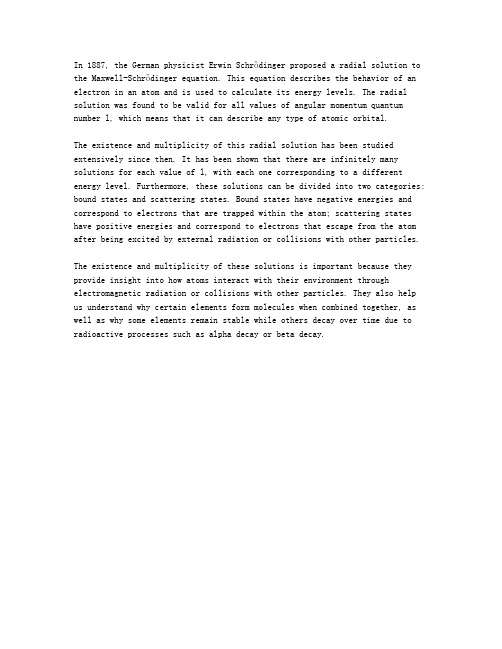
In 1887, the German physicist Erwin Schrödinger proposed a radial solution to the Maxwell-Schrödinger equation. This equation describes the behavior of an electron in an atom and is used to calculate its energy levels. The radial solution was found to be valid for all values of angular momentum quantum number l, which means that it can describe any type of atomic orbital.The existence and multiplicity of this radial solution has been studied extensively since then. It has been shown that there are infinitely many solutions for each value of l, with each one corresponding to a different energy level. Furthermore, these solutions can be divided into two categories: bound states and scattering states. Bound states have negative energies and correspond to electrons that are trapped within the atom; scattering states have positive energies and correspond to electrons that escape from the atom after being excited by external radiation or collisions with other particles.The existence and multiplicity of these solutions is important because they provide insight into how atoms interact with their environment through electromagnetic radiation or collisions with other particles. They also help us understand why certain elements form molecules when combined together, as well as why some elements remain stable while others decay over time due to radioactive processes such as alpha decay or beta decay.。
非自治p(t)-拉普拉斯系统周期解的存在性
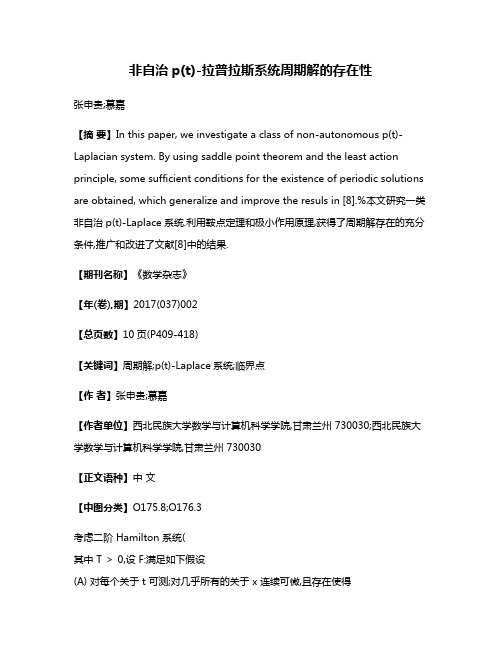
非自治p(t)-拉普拉斯系统周期解的存在性张申贵;慕嘉【摘要】In this paper, we investigate a class of non-autonomous p(t)-Laplacian system. By using saddle point theorem and the least action principle, some sufficient conditions for the existence of periodic solutions are obtained, which generalize and improve the resuls in [8].%本文研究一类非自治p(t)-Laplace系统.利用鞍点定理和极小作用原理,获得了周期解存在的充分条件,推广和改进了文献[8]中的结果.【期刊名称】《数学杂志》【年(卷),期】2017(037)002【总页数】10页(P409-418)【关键词】周期解;p(t)-Laplace系统;临界点【作者】张申贵;慕嘉【作者单位】西北民族大学数学与计算机科学学院,甘肃兰州 730030;西北民族大学数学与计算机科学学院,甘肃兰州 730030【正文语种】中文【中图分类】O175.8;O176.3考虑二阶 Hamilton 系统(其中 T > 0,设 F:满足如下假设(A) 对每个关于 t 可测;对几乎所有的关于 x 连续可微,且存在使得对所有的和成立.Mawhin 和 Willem 在文 [1]在非线性项有界,即存在使得对所有和成立时,得到了系统 (1.1) 周期解的存在性定理.文 [2]假设非线性项是次线性增长的,即存在使得对所有和成立.在具有线性增长非线性项,即存在f,g ∈ L1(0,T;R+),使得对所有x ∈ RN和 a.e.t ∈ [0,T]成立时,文 [3]中得到以下定理.定理A[3]设 F 满足 (1.2) 式, 且若则系统 (1.1) 在 Sobolev 空间 HT1中至少有一个周期解.文 [4]将定理 A 中的强制性条件改进为下方有界的情形当非线性项▽F(t,x) 线性增长时, 文 [5–7]中分别在具有部分周期位势, 脉冲作用项, 单调性条件下得到了二阶 Hamilton 系统周期解的存在性定理.设存在常数 M0> 0,M1> 0,M2> 0 和非负函数ω ∈ C([0,∞),[0,∞)), 使得受到文 [8]和 [9]的启发, 我们考虑用控制函数ω(|x|) 替换线性增长条件 (1.2) 中的|x|,并将上述结果推广到非自治 p(t)- 拉普拉斯系统其中p(t) ∈ C([0,T],R+),p(t)=p(t+T),且临界点理论是研究微分方程和差分方程边值问题可解性的有效方法, 如文 [10–12]. 非自治 p(t)- 拉普拉斯系统来自于非线性弹性问题和流体力学,该系统刻画了“逐点异性”的物理现象.近年来,临界点理论已用于研究非自治 p(t)- 拉普拉斯系统周期解的存在性,参见文[13–21].记p(t) ∈ C([0,T],R+), 定义当p−> 1 时,空间 W1,p(t)T 是自反的 Banach 空间,其范数为记则引理2.1,存在常数有其中引理2.2有引理2.3[16]在 Sobolev 空间 W1,p(t)T 上定义泛函ϕ如下:则u ∈ WT1,p(t)是问题 (1.3) 的周期解当且仅当 u 是泛函ϕ的临界点, 且ϕ连续可微,定义1设 X 为 Banach 空间, 若泛函ϕ∈ C1(X,R) 满足: 对任何点列 {un} ⊂ X, 由{ϕ(un)} 有界,ϕ′(un) → 0 蕴含 {un} 有收敛子列, 则称泛函ϕ满足 (PS) 条件.引理2.4[1](极小作用原理) 若泛函ϕ:X → R 弱下半连续, 且ϕ在自反的Banach 空间 X 中强制,即当‖u‖ → ∞ 时,有ϕ(u) → +∞,则泛函ϕ在空间 X 中有极小值.引理2.5[1](鞍点定理) 设 E 是 Hilbert 空间,E=E1⊕ E2, 其中 E2/={0} 是有限维子空间. 若ϕ∈ C1(X,R) 满足 (PS) 条件和以下两个条件(i) 存在e ∈ Bρ∩ E2和常数ω >σ, 使得ϕ|e+E1≥ ω; (ii) 存在常数σ 和ρ, 使得ϕ|∂Bρ∩E2≤ σ,则ϕ有临界值c≥ω且其中;id 表示恒等算子;Bρ是 E 中以 0 为中心半径为 r 的开球;∂Bρ表示Bρ的边界. 定理3.1设ω ∈ C([0,∞),[0,∞)),满足(ω1)–(ω4). 设存在f,g ∈ L1(0,T;R+), 使得对所有x ∈ RN和 a.e.t ∈ [0,T]成立,且则问题 (1.3) 在 Sobolev 空间 WT1 ,p(t)中至少有一个周期解.注定理 3.1 推广与改进了定理 A 和文献 [8]中定理 1.5. 首先, 定理 3.1 中将对应结果推广到了非自治 p(t)- 拉普拉斯系统;另一方面,易见式 (3.2) 中极限是下方有界的. 取p(t)≡ 2,则p−=p+=2,令其中β(t) ∈ L1(0,T;R+), 则 F 满足定理 3.1 的条件,但不满足定理 A 和文 [8]中定理 1.5.证由条件(ω1)–(ω3), 式 (3.1),(2.1),有利用 Young 不等式及,有由式 (3.4) 和 (3.5) 式,有Z由引理 1.2, 由式 (3.2) 和(ω4), 并注意到时. 注意到当p−> 1 时, 空间 WT1 ,p(t)是自反的 Banach空间, 泛函ϕ弱下半连续[20], 由极小作用原理可知, 泛函ϕ至少有一个临界点, 从而得到问题 (1.3) 至少有一个周期解.定理3.2设非负函数ω 满足F 满足 (3.1) 和 (3.3) 式,且其中则问题 (1.3) 在 Sobolev 空间 WT1 ,p(t)中至少有一个周期解.注取,则,令则 F 满足定理 3.2 中的条件,但不满足文 [13–21]中定理.Z证我们将利用鞍点定理来证明定理 3.2,设第1步证明泛函ϕ满足 (PS) 条件, 即任何点列, 由有界,可推得 {un} 有收敛子列. 首先证明有界.类似于 (3.4) 式的证明,有由式 (3.5),(3.8),有另一方面, 由式 (2.1),可得由式 (3.9),(3.10), 有其中. 由式 (3.9),有由式 (3.4),(3.5),(3.12),有其中 K 为式 (3.7) 中定义的正常数. 反设在 WT1,p(t)中无界,当由引理 2.2,当当n → ∞ 时,, 有ω(|u¯n|) → +∞. 由式 (3.6),(3.13), 并注意到p−> 1,当n → ∞ 时,当n→ ∞ 时, 式 (3.12), 有ω(|u¯n|) → +∞. 由式 (3.6),(3.13),并注意到p−> 1,当n → ∞ 时,ϕ(un) → −∞.这与有界矛盾! 故 {un} 在 WT1 ,p(t)中有界. 注意到当 p−> 1 时,WT1,p(t)紧嵌入C([0,T];RN) 和 WT1 ,p(t)的一致凸性, 类似于文献 [19]中定理 3.2 的证明,{un} 在 WT1,p(t)中有收敛子列,故泛函ϕ满足 (PS)条件.第2步取我们证明鞍点定理的环绕条件成立. 对u ∈ E1, 类似于 (3.4) 式的证明,有由式 (3.14),有对,由引理由 (3.3) 式知故当时, 有成立. 显然存在常数η,使得ϕ(u)≥ η.另一方面,对,由式 (3.6),∀ε> 0,当充分大时,有令ε充分小, 当时,, 则因此存在正常数ρ, 使得【相关文献】[1]Mawhin J,Willem M.Criticalpoint theory and Hamiltonian systems[M].NewYork:Springer Verlag, 1989.[2]Tang C L.Periodic solutions ofnon-autonomous second order systems with sublinear nonlinearity[J]. Proc.Amer.Math.Soc.,1998,126(11):3263–3270.[3]Zhao F K,Wu X.Existence of periodic solutions for nonautonmous second order systems with linear nonlinearity[J].Nonl.Anal.,2005,60(7):325–335.[4]Tang X H,Meng Q.Solutions of a second-order Hamiltonian system with periodic boundary conditions[J].Nonl.Anal.,2010,11:3722–3733.[5] 张申贵. 一类非自治二阶系统的多重周期解 [J]. 山东大学学报 (理学版),2011,46(11):64–69.[6]Chen P,Tang X H.Existence of solutions for a class of second-order p-Laplacian systems with impulsive eff ects[J].Appl.Math.,2014,59(5):543–570.[7] 吴越, 安天庆. 一类非自治二阶哈密顿系统的周期解 [J]. 吉林大学学报 (理学版),2013,51(1):57–63.[8]Wang Z Y,Zhang J H.Periodic solutions of a class of second order non-autonomous Hamiltonian systems[J].Nonl.Anal.,2010,72(12):4480–4487.[9]Zhang Q F,Tang X H.Periodic solutions for second ordersystems[J].Appl.Math.,2012,41(5), 303–310.[10] 彭艳芳.R3中一类 Kirchhoff 型方程变号解的存在性及集中性 [J]. 数学杂志,2015,35(1):75–84.[11] 敖恩, 张国伟. 关于二阶半线性椭圆方程的 Dirichlet 边值问题一个注记 [J]. 数学杂志,2014,34(1): 37–42.[12] 张克玉, 徐家发. 一类二阶差分方程边值问题解的存在性 [J]. 数学杂志,2014,34(5):857–862.[13]Ge B,Xue X P,ZHOU Q M.Existence of periodic solutions for a diff erential inclusion systems involving the p(t)-Laplacian[J].Acta Math.Sci.,2011,31B(5):1786–1802.[14]Fan X L.A Knobloch-type result for p(t)-Laplaciansystems[J].J.Math.Anal.Appl.,2003,282(3): 453–464.[15]Zhang L,Tang X H,Chen J.Infinitely many periodic solutions for some second-order diff erential systems with p(t)-Laplacian[J].Boundary Value Problems,2011,33(2):1–15.[16]Wang X J,Yuan R.Existence of periodic solutions for p(t)-Laplaciansystems[J].Nonl.Anal.,2009, 70(1):866–880.[17] 张申贵. 一类超线性 p(t)-Laplacian 系统的无穷多周期解 [J]. 吉林大学学报 (理学版),2014,52(1): 34–38.[18]Zhang L,Tang X H.Existence and multiplicity ofperiodic solutions for some second order diff erential systems with p(t)-Laplacian[J].Math.Slovaca,2013,63(6):1269–1290. [19]Zhang L,Tang X H.Subharmonic solutions for some nonautonomous Hamiltonian systems with p(t)-Laplacian[J].Bull.Belg.Math.Soc.(2),2011,18(2):385–400.[20]Zhang L,Chen Y.Existence of periodic solutions of p(t)-Laplaciansystems[J].Bull.Malays.Math. Sci.Soc.(2),2012,35(1):25–38.[21]Chen P,Tang X H,Agarwal R.Existence of homoclinic solutions for p(n)-Laplacian Hamiltonian systems on orlicz sequence space[J]put.Model.,2012,55(3):989–1002.。
弱次线性增长条件下脉冲系统的周期解
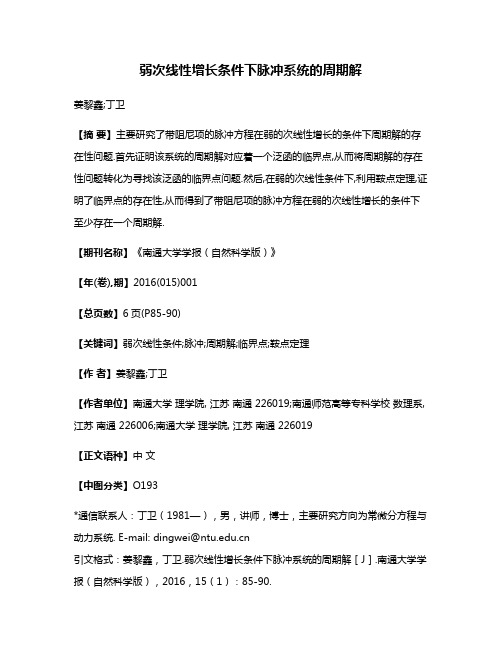
弱次线性增长条件下脉冲系统的周期解姜黎鑫;丁卫【摘要】主要研究了带阻尼项的脉冲方程在弱的次线性增长的条件下周期解的存在性问题.首先证明该系统的周期解对应着一个泛函的临界点,从而将周期解的存在性问题转化为寻找该泛函的临界点问题.然后,在弱的次线性条件下,利用鞍点定理,证明了临界点的存在性,从而得到了带阻尼项的脉冲方程在弱的次线性增长的条件下至少存在一个周期解.【期刊名称】《南通大学学报(自然科学版)》【年(卷),期】2016(015)001【总页数】6页(P85-90)【关键词】弱次线性条件;脉冲;周期解;临界点;鞍点定理【作者】姜黎鑫;丁卫【作者单位】南通大学理学院, 江苏南通 226019;南通师范高等专科学校数理系, 江苏南通 226006;南通大学理学院, 江苏南通 226019【正文语种】中文【中图分类】O193*通信联系人:丁卫(1981—),男,讲师,博士,主要研究方向为常微分方程与动力系统.E-mail:***************.cn引文格式:姜黎鑫,丁卫.弱次线性增长条件下脉冲系统的周期解[J].南通大学学报(自然科学版),2016,15(1):85-90.脉冲微分方程是现实生活中用以描述在动态过程中突然发生不连续跳跃的动力系统.近几年来,脉冲问题吸引了许多学者的关注,并取得了大量的研究成果[1-9].一般来说,研究二阶微分方程x″+ f(t,x,x′)= 0的脉冲理论,应该对位置x以及速度x′都要考虑脉冲,但是,对于航天飞船的运动轨迹,我们有时仅需要考虑在速度x′上产生了脉冲,而在位置x上没有变化[10-11].令t0= 0 < t1< t2<…< tp< tp + 1= 2π,文献[12-13]中利用变分法研究了如下带脉冲的Dirichlet边值问题:其中,f∶[0,2π]×R→R是连续的,p∈C[0,2π],对每一个j = 1,2,…,p,脉冲函数Ij∶R→R也是连续的.进一步,若p(t)= 0,式(1)退化为无阻尼的二阶常微分方程当f∶[0,2π]×R→R满足Carathéodory条件时,文献[5]研究了带周期边界条件的脉冲系统(4)-(2)的解的存在性问题,得到了若f(t,x)是次线性增长的,即对任意的x∈R以及a.e.t∈[0,2π]存在g,h∈L1(0,2π,R+),α∈[0,1),使得以及并且存在常数a,b≥0,γ∈[0,α)使得脉冲函数满足则脉冲问题(4)-(2)-(5)至少存在一个周期解.上述函数f(t,x)满足Carathéodory条件是指1)对任意x∈R,f(·,x)在[0,2π]上可测;2)对a.e. t∈[0,2π],f(t,·)在R上连续;3)对任意的x∈R以及a.e. t∈[0,2π]存在函数u∈С(R+,R+)以及v∈С([0,2π],R+)使得其中当p(t)不恒为0时,脉冲系统(1)-(2)-(5)在怎样的条件下存在周期解?这是本文将研究的问题.在接下来的文章中,我们总假设p∈С[0,2π]是2π周期的,且,其中,.显然G∈С[0,2π]是2π周期的,则我们有如下的周期解存在性定理.定理1 若A >1,并假设Carathéodory函数2 f(t,x)满足条件(6)以及并且脉冲函数满足式(7)以及则脉冲系统(1)-(2)-(5)至少存在一个2π周期解.注1:令F(t,x)dt,则对任意充分小的正数η,存在M > 0,使得.在式(7)中取a = b = 0,则脉冲系统(1)-(2)退化为一个通常的带阻尼项的二阶常微分方程,于是可以得到下面的推论.推论1 若,并假设Carathéodory函数f(t,x)满足条件(6)以及则方程(1)-(5)至少存在一个周期解.在方程(1)两侧同乘以eG(t),方程(1)等价于方程因此脉冲系统(1)-(2)-(5)等价于系统(11)-(2)-(5).定义Hilbert空间其范数为.对,有:由式(13)易得定义上的泛函φ(x)如下:可以得到以下一些结果.引理1 在上文的假设条件下,泛函φ(x)在上是连续可微的,且对任意的v∈,成立.引理2 在上文的假设条件之下,如果x∈是泛函φ(x)的一个临界点,那么x就是问题(11)-(2)-(5)的一个2π周期解.注2:该引理来自文献[14],为了文章的完整性以及方便读者,这里也给出相应的证明.证明:令x是函数φ在上的一个临界点,那么∀v =,有现在证明x满足(11)-(2)-(5).因为,我们有x(0)= x(2π).显然,索伯列夫空间,对每一个确定的j∈{0,1,2,…,p},令那么∀v∈(tj,tj + 1).于是(eG(t)x′)′+ eG(t)f(t,x)= 0,a.e.t∈[tj,tj + 1].因此x满足即满足方程(11).取v∈(0,2π),把式(16)两端乘上v,并在0到2π之间求积分即得到通过部分积分,我们有联合式(15),可得因此这样就得到了式(2).另一方面,在式(15)中,令v = 1,那么此外,式(16)两端在0到2π之间求积分,得到即最后,通过式(17),(18),(19)和G(2π)= G(0),有x′(0)= x′(2π).引理2 得证.引理3 在定理1的条件下,泛函φ满足P.S条件,即,对H12π中的任何序列{xn},如果满足{φ(xn)}有界,而且φ′(xn)→0,n→∞,则{xn}存在一个收敛子列.证明:由条件(6)及(12)可知存在c1,c2> 0,使得即对所有的xn成立.其中δ1是一个可以任意小的正常数,M1是依赖于δ1的正常数.另一方面,由式(7)可知存在常数c3,c4> 0,使得于是存在c > 0,对所有的xn成立其中,ε> 0可以任意小,M2是依赖于δ2的一个正常数.又因为φ′(xn)→0,as,n→∞,于是当ε,δ1,δ2充分小时,有于是存在依赖于ε,δ1,δ2的正数M3,使得利用证明不等式(20)的方法,可以得到类似地,由条件(10)可以得到由式(21),(22),(23)以及注1,可得:其中M4是取决于η,δ1,δ2和ε的正常数.综上可知是有界的.事实上,如果是无界的,我们可以设(如有必要,可以选取一子列)当ε,δ1,δ2足够小,Q(ε,δ1,δ2)对每一个变量都是单调递增的,进一步可以得到因为,令η,δ1,δ2足够小,使得由γ<α,就有φ(xn)→-∞,n→∞,这与{φ(xn)}是有界的矛盾.因此,有界.由式(21)以及式(14)可知{xn}在H12π上是有界的.最后,通过标准分析可得{xn}在H12π中存在收敛子列.引理3 得证.下面是定理1的证明.令⊕R.当x∈R,由注1和式(23)可知存在正常数M1,使得于是由式(6),(11)和(23),对,存在d > 0,使得因为γ∈[0,1),由式(14),我们有:在上,当‖x‖→∞时,有由式(24),(25)和鞍点定理[15],函数φ(x)存在一个临界点,因此,问题(1)-(2)-(5)至少有一个2π周期解.证毕.【相关文献】[1]NIETO J J. Basic theory for nonresonance impulsive periodic problems of first order [J]. Journal of Mathematical Analysis and Applications,1997,205(2):423-433. [2]DONGYJ.Sublinearimpulseeffectsandsolvabilityofboundary value problems for differential equations with impulses[J]. Journal of Mathematical Analysis and Applications,2001,264(1):32-48.[3]NIETO J J. Periodic boundary value problems for first-order impulsiveordinarydifferentialequations[J].NonlinearAnalysis:Theory,Methods & Applications,2002,51(7):1223-1232.[4]NIETO J J. O′Regan D. Variational approach to impulsive differenti al equations[J]. Nonlinear Analysis:Real World Applications,2009,10(2):680-690.[5]DING W,QIAN D B. Periodic solutions for sublinear systems via variational approach[J]. Nonlinear Analysis:Real World Applications,2010,11(4):2603-2609. [6]ZHOU J W,LI Y K. Existence and multiplicity of solutions forsomeDirichletproblemswithimpulsiveeffects[J].Nonlinear Analysis Theory,Methods & Applications,2009,71(7/8):2856-2865.[7]ZHANG H,LI Z X. Periodic solutions of second-order nonautonomous impulsive differential equations[J]. International Journal of Qualitative Theory of Differential Equations and Applications,2008,2(1):112-124.[8]ZHANG Z H,YUAN R. An application of variational methods to Dirichletboundary value problem with impulses[J]. Nonlinear Analysis:Real World Applicatiions,2010,11(1):155-162.[9]SUN J T,O′REGAN D. Impulsive periodic solutions for singular problems via variational methods[J]. Bulletin of the Australian Mathematical Society,2012,86(2):193-204.[10]CARTER T E. Optimal impulsive space trajectories based on linear equations[J]. Journal of Optimization Theory and Applications,1991,70(2):277-297.[11]CARTER T E. Necessary and sufficient conditions for optimal impulsive rendezvous with linear equations of motion[J]. Dynamics and Control,2000,10(3):219-227. [12]NIETO J J. Variational formulation of a damped Dirichlet impulsive problem[J]. Applied Mathematics Letters,2010,23(8):940-942.[13]XIAO J,NIETO J J. Variational approach to some damped Dirichletnonlinearimpulsivedifferentialequations[J].Journal of the Franklin Institute,2011,348(2):369-377.[14]JIANG L X,DING W. Periodic solutions of damped impulsive systems[J]. Accepted by Journal of Mathematics.[15]MAWBIN J,WILLEM M. Critical point theory and hamiltonian systems[M]. New York:Springer-Verlag,1989.。
关于《 Existence and Multiplicity of Traveling Waves in a lattice Dynamical System》的注记
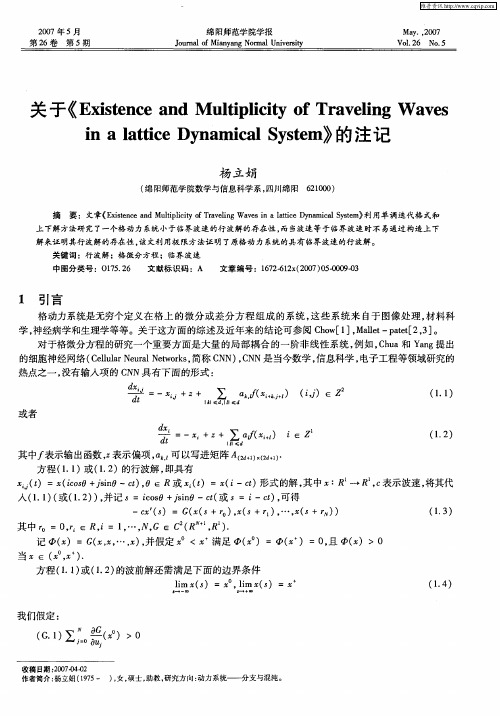
()= (cs s 0一c)0∈R或 () = i t 形 式 的解 , 中 : R ,表 示波速 , 其代 t i O+ji o n t, t ( —c) 其 R 一 c 将 人 (. ) 或 (. ) , 记 s=io0+ s 0一c( s= i t, 11 ( 12 )并 cs ji n t或 —c)可得
文献标 识码 :A
文章编号 :17 &1x 20 ) 500 - 62 2 (0 7 0 -0 90 3
1 引言
格 动力系统是无 穷个定 义 在 格 上 的微 分或 差 分 方 程 组 成 的系 统 , 些 系统 来 自于 图像 处 理 , 料科 这 材
学, 神经病学和生理学等等。关于这方面的综述及近年来的结论可参阅 C o [ ]M lt pt [ ,] hw 1 , ae— a t 3 。 l e2 对于格微 分方程 的研究 一个重要 方 面是大 量 的局 部 耦合 的一阶 非线 性 系统 , 如 , ha和 Y n 出 例 Cu ag提
杨 立 娟
( 阳师范学院数学与信息科学系 , 绵 四川绵 阳 6 10 ) 2 00 摘 要:文章( x t c n ut l i f rvl gWae tc ya i l yt 利用单调迭代格 式和 E ie eadM lpit o Tae n vsi alt eD n mc s m) sn ic y i n ai aS e
上下解方法研究 了一个格动力 系统小于临界 波速 的行 波解的存在性 , 当波速等 于临界 波速 时不 易通过构造上 下 而
解来证 明其行波解的存在性 , 该文利用极 限方 法证 明了原格动力 系统的具有 临界波速的行 波解 。
关 键 词 :行 波解 ;格 微 分 方程 ; 临界 波 速
关于p(l)-拉普拉斯非线性边值问题的正解
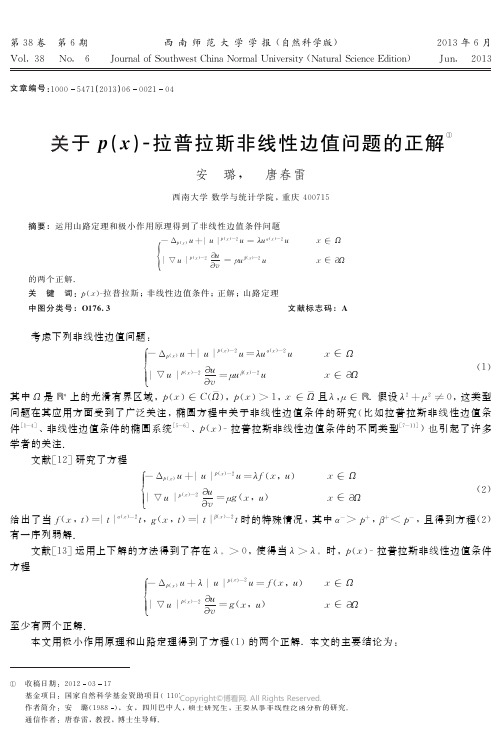
第38卷 第6期西南师范大学学报(自然科学版)2013年6月V o l .38 N o .6 J o u r n a l o f S o u t h w e s t C h i n aN o r m a lU n i v e r s i t y (N a t u r a l S c i e n c eE d i t i o n )J u n .2013文章编号:10005471(2013)06002104关于p (x )-拉普拉斯非线性边值问题的正解①安 璐, 唐春雷西南大学数学与统计学院,重庆400715摘要:运用山路定理和极小作用原理得到了非线性边值条件问题-Δp (x )u +|u |p(x )-2u =λu α(x )-2u x ɪΩ|∇u |p(x )-2췍u 췍v=μu β(x )-2u x ɪ{췍Ω的两个正解.关 键 词:p (x )-拉普拉斯;非线性边值条件;正解;山路定理中图分类号:O 176.3文献标志码:A考虑下列非线性边值问题:-Δp (x )u +|u |p (x )-2u =λu α(x )-2u x ɪΩ|∇u |p (x )-2췍u 췍v =μuβ(x )-2u x ɪìîíïïï췍Ω(1)其中Ω是R n 上的光滑有界区域,p (x )ɪC (췍Ω),p (x )>1,x ɪ췍Ω且λ,μɪR .假设λ2+μ2ʂ0,这类型问题在其应用方面受到了广泛关注,椭圆方程中关于非线性边值条件的研究(比如拉普拉斯非线性边值条件[1-4]㊁非线性边值条件的椭圆系统[5-6]㊁p (x )-拉普拉斯非线性边值条件的不同类型[7-11])也引起了许多学者的关注.文献[12]研究了方程-Δp (x )u +|u |p (x )-2u =λf (x ,u ) x ɪΩ|∇u |p (x )-2췍u 췍v =μg (x ,u) x ɪìîíïïï췍Ω(2)给出了当f (x ,t )=|t |α(x )-2t ,g (x ,t )=|t |β(x )-2t 时的特殊情况,其中α->p +,β+<p -,且得到方程(2)有一序列弱解.文献[13]运用上下解的方法得到了存在λ*>0,使得当λ>λ*时,p (x )-拉普拉斯非线性边值条件方程-Δp (x )u +λ|u |p (x )-2u =f (x ,u ) x ɪΩ|∇u |p (x )-2췍u 췍v =g (x ,u ) x ɪìîíïïï췍Ω至少有两个正解.本文用极小作用原理和山路定理得到了方程(1)的两个正解.本文的主要结论为:①收稿日期:20120317基金项目:国家自然科学基金资助项目(11071198).作者简介:安 璐(1988),女,四川巴中人,硕士研究生,主要从事非线性泛函分析的研究.通信作者:唐春雷,教授,博士生导师.Copyright©博看网. All Rights Reserved.定理1 假设α(x )<p *(x ),β(x )<p *(x )成立.当α->p +,β+<p -时,存在μ0>0,使得当μɪ(0,μ0)时,方程(1)有两个正解.1 预备知识为了寻求方程(1)的非负弱解,定义在W 1,p (x )(Ω)上的泛函J (u )=ʏΩ1p (x )[|∇u |p (x )+|u |p (x )]d x -λʏΩ1α(x )|u |α(x )d x -μʏ췍Ω1β(x )|u |β(x )d σ 性质1[14-15] (i )W 1,p (x )(Ω)是自反的可分离的B a n a c h 空间;(i i )如果∀x ɪ췍Ω,q (x )ɪC +(췍Ω)且q (x )<p *(x ),则W 1,p (x )(Ω)到L q (x )(Ω)的嵌入是紧连续的,其中p *(x )=N p (x )N -p (x )p (x )<N ɕp (x )ȡ{N 性质2[12] 如果∀x ɪ췍Ω,q (x )ɪC +(췍Ω)且q (x )<p *(x ),则W 1,p (x )(Ω)到L q (x )(췍Ω)的嵌入是紧连续的,其中p *(x )=(N -1)p (x )N -p (x )p (x )<Nɕp (x )ȡ{N 2 主要结论的证明定理1的证明 不妨记f (x ,t )=|t |α(x )-2t g (x ,t )=|t |β(x )-2t 令F (x ,t )=ʏt 0f (x ,s )d s G (x ,t )=ʏtg (x ,s )d s 不失一般性,假设f (x ,t )=f (x ,0) t <0,x ɪ췍Ωg (x ,t )=g (x ,0) t <0,x ɪ췍Ω不妨假设 u <1,当α->p +,β+<p -时,有J (u )=ʏΩ1p (x )(|∇u |p (x )+|u |p (x ))d x -λʏΩ1α(x )|u |α(x )d x -μʏ췍Ω1β(x )|u |β(x )d σȡ1p +u p +-λC α- u α--μC β- u β-因为α->p +,所以存在非常小的ρ0>0,使得当0<ρ= u <ρ0时,有λC α- u α-ɤ12p+ u p +,则J (u )ȡ12p + u p +-μC β- u β-取μ0=12Cρp +-β->0,使得当μɪ(0,μ0)时,有J (u )ȡ0.因为α-<p +<β-,则存在μ0>0,使得μɪ(0,λ0)时有J (u )>0成立.因为β+<p -,所以对∀0<t <1,存在常数C 1>0和正常数d <p -,使得G (x ,t )ȡC 1|t |d又因为α->p +,所以对任意给定的M 1>0,当t ȡM 1时,存在θ>p +,C 2>0,使得F (x ,t )ȡC 2|t |θ所以对∀t >0,取u ʉM >0,当0<t <1时,有J (t u 0)ɤtp-p-ʏΩ|M |p (x )d x -λʏΩ1α(x )|t M |α(x )d x -μʏ췍Ω1β(x )|t M |β(x )d σɤ22西南师范大学学报(自然科学版) h t t p ://x b b jb .s w u .c n 第38卷Copyright ©博看网. All Rights Reserved.t p-p-ʏΩ|M |p (x)d x -λʏΩC 2|t M |θd x -μʏ췍ΩC 1|t M |d d σ=D 1t p-p--λD 2t θ-μD 3t d因为θ>p +>p ->d ,所以存在0<t 0<1,使得J (t 0u )<0成立.定义췍B ρ={u ɪW 1,p (x )(Ω): u <ρ} 췍B ρ={u ɪW 1,p (x )(Ω): u =ρ}由性质1和性质2,易得J 是弱下半连续的.令c =i n f {J (u ):u ɪ췍B ρ}则可以得到c <0事实上,只要s >0足够小,就可以得到J (s u )<0,所以c <0.因此J 在췍Bρ上有极小值点u 1,并且极小值点不在边界上.也就是说u 1是方程(1)的非零非负解.由强极大值原理可知,非零非负解都是方程(1)的正解.取ΩɪW 1,p (x )(Ω)\{0},ω(x )ʉM .对t >1,θ>p +,有J (t Ω)=ʏΩt p (x)p (x )(|∇ω|p (x )+|ω|p (x ))d x -λʏΩ1α(x )|t ω|α(x )d x -μʏ췍Ω1β(x )|t Ω|β(x )d σɤt p+p -ʏΩM p (x )d x -λʏΩC α(x )|t ω|θd x +c ң2-ɕ接下来证明{u n }⊂W 1,p (x )(Ω)是(P S )序列.当T =l i m ңn ɕJ (u n )<+ɕ,J ᶄ(u n ң)0,且n 充分大时,T +1ȡJ (u n )-1α-<J ᶄ(u n ),u n >+1α-<J ᶄ(u n ),u n >=ʏΩ1p (x )(|∇u n |p (x )+|u n |p (x ))d x -λʏΩ1α(x )|u n |α(x )d x -μʏ췍Ω1β(x)|u n |β(x )d σ-1α-[ʏΩ(|∇u n|p (x )+|u n |p(x ))d x -λʏΩ|u n|α(x )d x -μʏ췍Ω|u n |β(x )d σ]+1α-<J ᶄ(u n ),u n >ȡ1p +-1αéëêêùûúú- u n p --c 1 u n β+-1α- J ᶄ(u n ) u n -c 2ȡ1p +-1αéëêêùûúú- u n p --c 3 u n β+-1α- u n 因为β+<p -,所以{u n }在W 1,p (x )上有界.由山路定理可知,若{u n }在W 1,p (x )(Ω)中是有界的,则存在u 2ɪW 1,p (x )(Ω),使得J ᶄ(u 2)=0,J (u 2)=c >0,且u 2是方程(1)的非负弱解,由强极大值原理可知u 2也是正解,并且u 2不同于u 1,因为J (u 1)<0.即当α->p +,β+<p -时,方程(1)有两个正解.类似地,可得:定理2 假设α(x )<p *(x ),β(x )<p *(x )成立.当α+<p -,β->p +时,存在λ0>0,使得当λɪ(0,λ0)时,方程(1)有两个正解.参考文献:[1]C H I P O T M ,C H L E B K M ,F I L A M ,e t a l .E x i s t e n c e o f P o s i t i v e S o l u t i o n s o f a S e m i l i n e a r E l l i p t i cE q u a t i o n i nR nCw i t h aN o n l i n e a rB o u n d a r y C o n d i t i o n [J ].JM a t hA n a lA p pl ,1998,223(2):429-471.[2] C H I P O T M ,S HA F R I RI ,F I L A M.O n t h eS o l u t i o n s t oS o m eE l l i p t i cE q u a t i o n sw i t hN o n l i n e a rB o u n d a r y C o n d i t i o n s [J ].A d vD i f f e r e n t i a l E qu a t i o n s ,1996(1):91-110.[3] HU B e i .N o n e x i s t e n c e o f aP o s i t i v e S o l u t i o n o f t h eL a p l a c eE q u a t i o nw i t h aN o n l i n e a r B o u n d a r y C o n d i t i o n [J ].D i f f e r e n -32第6期 安 璐,等:关于p (x )-拉普拉斯非线性边值问题的正解Copyright ©博看网. All Rights Reserved.t i a l I n t e g r a l E qu a t i o n s ,1994(7):301-313.[4] T E R R A C C I N I S .S y mm e t r y P r o p e r t i e s o f P o s i t i v e S o l u t i o n s t oS o m eE l l i p t i cE q u a t i o n sw i t hN o n l i n e a r B o u n d a r y C o n d i -t i o n s [J ].D i f f e r e n t i a l I n t e g r a l E qu a t i o n s ,1995(8):1911-1922.[5] B O N D E RJF ,P I N A S C OJP ,R O S S I JD.E x i s t e n c eR e s u l t s f o rH a m i l t o n i a nE l l i p t i c S y s t e m sw i t hN o n l i n e a r B o u n d a r y C o n d i t i o n s [J ].E l e c t r o n JD i f f e r e n t i a l E q u a t i o n s ,1999,1999(40):1-15.[6] B O N D E RJF ,R O S S I JD.E x i s t e n c e f o r a nE l l i p t i cS y s t e m w i t hN o n l i n e a rB o u n d a r y C o n d i t i o n sV i aF i x e dP o i n tM e t h -o d s [J ].A d vD i f f e r e n t i a l E qu a t i o n s ,2001(6):1-20.[7] MA R T I N E ZS ,R O S S I JD.W e a kS o l u t i o n s f o r t h e p -L a p l a c i a nw i t h aN o n l i n e a r B o u n d a r y C o n d i t i o n a tR e s o n a n c e [J ].E l e c t r o n JD i f f e r e n t i a l E q u a t i o n s ,2003,2003(27):1-14.[8] B O N D E RJF ,R O S S I JD.E x i s t e n c eR e s u l t s f o r t h e p -L a p l a c i a nw i t hN o n l i n e a r B o u n d a r y C o n d i t i o n s [J ].JM a t hA n a l A p pl ,2001,263(1):195-223.[9] P F L ÜG E R K.E x i s t e n c e a n dM u l t i p l i c i t y o f S o l u t i o n s t o a p -L a p l a c i a nE q u a t i o nw i t hN o n l i n e a r B o u n d a r y C o n d i t i o n [J ].E l e c t r o n JD i f f e r e n t i a l E q u a t i o n s ,1998,1998(10):1-13.[10]C ÏR S T E A F CS ,R A D U L E S C U V.E x i s t e n c ea n d N o n -E x i s t e n c eR e s u l t sf o ra Q u a s i l i n e a rP r o b l e m w i t h N o n l i n e a r B o u n d a r y C o n d i t i o n [J ].JM a t hA n a lA p p l ,2000,244(1):169-183.[11]S O N GS h u -z h i ,T A N G C h u n -l e i .R e s o n a n c eP r o b l e m s f o r t h e p -L a p l a c i a n w i t haN o n l i n e a rB o u n d a r y C o n d i t i o n [J ].N o n l i n e a rA n a l ,2006,64(9):2007-2021.[12]Y A OJ i n g -h u a .S o l u t i o n s f o rN e u m a n nB o u n d a r y V a l u eP r o b l e m s I n v o l v i n g p (x )-L a p l a c eO p e r a t o r s [J ].N o n l i n e a rA -n a l ,2008,68(5):1271-1283.[13]AM S T E RP ,C R I S T I N A M ,M ÉN D E ZO.N o n l i n e a r B o u n d a r y C o n d i t i o n s f o rE l l i p t i cE q u a t i o n s [J ].E l e c t r o n JD i f f e r -e n t i a l E q u a t i o n s ,2005,144:1-8.[14]D E N GY i n -b i n ,P E N GS h u a n g -j i e .E x i s t e n c e o fM u l t i p l eP o s i t i v e S o l u t i o n s f o r I n h o m o g e n e o u sN e u m a n nP r o b l e m [J ].J M a t hA n a lA p p l ,2002,271(2):155-174.[15]G I L B A R GD ,T R U D I N G E R NS .E l l i p t i cP a r t i a l D i f f e r e n t i a l E q u a t i o n s o f S e c o n dO r d e r [M ].2t h e d .B e r l i n :S p r i n g e r -V e r l a g,1983.O nP o s i t i v e S o l u t i o n t o p (x )-L a p l a c i a nN o n l i n e a rB o u n d a r y Va l u e A N L u , T A N GC h u n -l e i S c h o o l o fM a t h e m a t i c sa n dS t a t i s t i c s ,S o u t h w e s t U n i v e r s i t y ,C h o n g q i n g 400715,C h i n a A b s t r a c t :T h i s t h e s i s i s r e l a t e d t o t h e s t u d y of -Δp (x )u +|u |p (x )-2u =λu α(x )-2u x ɪΩ|∇u |p (x )-2췍u 췍v =μu β(x )-2u x ɪìîíïïï췍ΩT w o p o s i t i v es o l u t i o n st oc o n d i t i o n so fn o n l i n e a rb o u n d a r y v a l u eh a v eb e e no b t a i n e da c c o r d i n g t ot h e m o u n t a i n p a s s t h e o r e ma n d t h e l e a s t a c t i o n p r i n c i pl e .K e y wo r d s :p (x )-L a p l a c e ;n o n l i n e a r b o u n d a r y v a l u e ;p o s i t i v e s o l u t i o n ;t h em o u n t a i n p a s s t h e o r e m 责任编辑 廖 坤42西南师范大学学报(自然科学版) h t t p ://x b b jb .s w u .c n 第38卷Copyright ©博看网. All Rights Reserved.。
带参数的非线性简单支撑静态梁方程正解的存在性及多解性
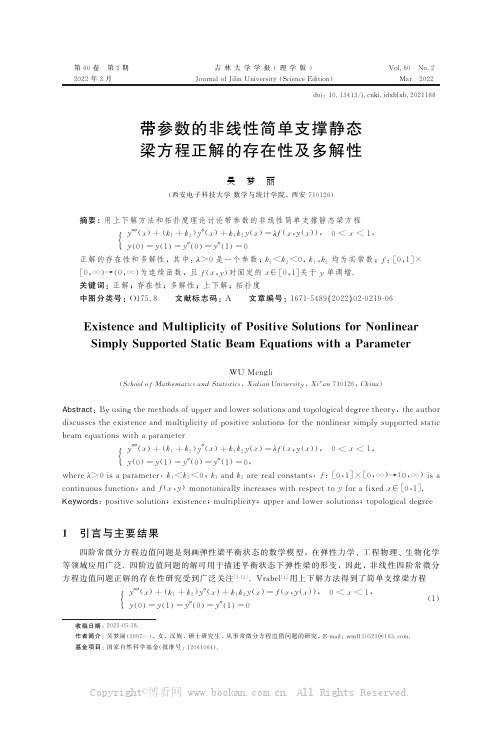
第60卷 第2期吉林大学学报(理学版)V o l .60 N o .22022年3月J o u r n a l o f J i l i nU n i v e r s i t y (S c i e n c eE d i t i o n )M a r 2022d o i :10.13413/j .c n k i .jd x b l x b .2021188带参数的非线性简单支撑静态梁方程正解的存在性及多解性吴 梦 丽(西安电子科技大学数学与统计学院,西安710126)摘要:用上下解方法和拓扑度理论讨论带参数的非线性简单支撑静态梁方程y ᵡᵡ(x )+(k 1+k 2)y ᵡ(x )+k 1k 2y (x )=λf (x ,y (x )), 0<x <1,y (0)=y (1)=y ᵡ(0)=y ᵡ(1)={0正解的存在性和多解性,其中:λ>0是一个参数;k 1<k 2<0,k 1,k 2均为实常数;f :[0,1]ˑ[0,ɕ)ң(0,ɕ)为连续函数,且f (x ,y )对固定的x ɪ[0,1]关于y 单调增.关键词:正解;存在性;多解性;上下解;拓扑度中图分类号:O 175.8 文献标志码:A 文章编号:1671-5489(2022)02-0219-06E x i s t e n c e a n dM u l t i p l i c i t y ofP o s i t i v e S o l u t i o n s f o rN o n l i n e a r S i m p l y S u p p o r t e dS t a t i cB e a mE qu a t i o n sw i t haP a r a m e t e r WU M e n gl i (S c h o o l o f M a t h e m a t i c s a n dS t a t i s t i c s ,X i d i a nU n i v e r s i t y ,X i a n 710126,C h i n a )A b s t r a c t :B y u s i n g t h em e t h o d s o f u p p e r a n d l o w e r s o l u t i o n s a n d t o p o l o g i c a l d e g r e e t h e o r y,t h e a u t h o r d i s c u s s e s t h e e x i s t e n c e a n dm u l t i p l i c i t y o f p o s i t i v e s o l u t i o n s f o r t h en o n l i n e a r s i m p l y s u p p o r t e ds t a t i c b e a me qu a t i o n sw i t ha p a r a m e t e r y ᵡᵡ(x )+(k 1+k 2)y ᵡ(x )+k 1k 2y (x )=λf (x ,y (x )), 0<x <1,y (0)=y (1)=y ᵡ(0)=y ᵡ(1)=0{,w h e r e λ>0i s a p a r a m e t e r ,k 1<k 2<0,k 1a n d k 2a r e r e a l c o n s t a n t s ,f :[0,1]ˑ[0,ɕ)ң(0,ɕ)i s a c o n t i n u o u s f u n c t i o n ,a n d f (x ,y )mo n o t o n i c a l l y i n c r e a s e sw i t h r e s p e c t t o y f o r a f i x e d x ɪ[0,1].K e y w o r d s :p o s i t i v e s o l u t i o n ;e x i s t e n c e ;m u l t i p l i c i t y ;u p p e r a n d l o w e r s o l u t i o n s ;t o p o l o g i c a l d e g r e e 收稿日期:2021-05-18.作者简介:吴梦丽(1997 ),女,汉族,硕士研究生,从事常微分方程边值问题的研究,E -m a i l :w m l 110521@163.c o m.基金项目:国家自然科学基金(批准号:12061064).1 引言与主要结果四阶常微分方程边值问题是刻画弹性梁平衡状态的数学模型,在弹性力学㊁工程物理㊁生物化学等领域应用广泛.四阶边值问题的解可用于描述平衡状态下弹性梁的形变,因此,非线性四阶常微分方程边值问题正解的存在性研究受到广泛关注[1-12].V r a b e l [1]用上下解方法得到了简单支撑梁方程y ᵡᵡ(x )+(k 1+k 2)y ᵡ(x )+k 1k 2y (x )=f (x ,y (x )), 0<x <1,y (0)=y (1)=y ᵡ(0)=y ᵡ(1)={0(1)Copyright©博看网 . All Rights Reserved.正解的存在性结果,其中f (x ,y )对y 单调,k 1<k 2<0.M a 等[2]通过构造格林函数,证明格林函数的正性,得到如下结果:定理1[2] 假设0<k 1<k 2<x 21,x 1是方程xc o s (x )+s i n (x )=0的第一个正解,令E ={(x ,u )ɪℝ2:0ɤx ɤ1,α(x )ɤu ɤβ(x )}.若问题(1)存在下解α和上解β,且满足α(x )ɤβ(x ),x ɪ[0,1],f :E ңℝ是连续函数,且当α(x )ɤu 1ɤu 2ɤβ(x )时,f (x ,u 1)ɤf (x ,u 2),x ɪ[0,1].则问题(1)存在一个解y (x ),且满足α(x )ɤy (x )ɤβ(x ), 0ɤx ɤ1.受上述研究结果启发,本文在f 对第二个变量单调增的条件下通过构造上下解,用拓扑度理论讨论两端简单支撑梁方程y ᵡᵡ(x )+(k 1+k 2)y ᵡ(x )+k 1k 2y (x )=λf (x ,y (x )), 0<x <1,y (0)=y (1)=y ᵡ(0)=y ᵡ(1)={0(2)正解的存在性和多解性.本文总假设:(H 1)λ>0是一个参数,k 1<k 2<0是实常数;(H 2)f :[0,1]ˑ[0,ɕ)ң(0,ɕ)是连续函数;(H 3)f (x ,y )对固定的x ɪ[0,1]关于y 单增;(H 4)f ɕ=l i m y ңɕf (x ,y )y=ɕ对x ɪ[0,1]一致成立.本文主要结果如下:定理2 假设(H 1),(H 2),(H 4)成立,则当λ充分小时,问题(2)至少存在一个正解;当λ充分大时,问题(2)不存在正解.定理3 假设(H 1)~(H 4)成立,则存在λ*>0,使得当0<λ<λ*时,问题(2)至少存在两个正解;当λ=λ*时,问题(2)至少存在一个正解;当λ>λ*时,问题(2)不存在正解.注1 由假设条件(H 2),可知f 0=l i m y ң0f (x ,y )y=ɕ对x ɪ[0,1]一致成立.在定理2中用常用的锥上不动点定理可证明存在μ*,μ*>0,使得当λɪ(0,μ*)时,问题(2)存在两个正解;当λ>μ*时,问题(2)不存在正解.但在μ*与μ*之间解的情况未知,μ*能否与μ*相等也未知.本文用上下解和拓扑度方法不仅得到了问题(2)在μ*=μ*处解的情况,而且得到了问题(2)的多解性.2 预备知识引理1[13] 设X 是B a n a c h 空间且K 是X 中的一个锥.当r >0时,定义K r ={x ɪK x <r }.假设T :췍K r ңK 是紧算子,使得当x ɪ∂K r 时,T x ʂx .1)若x ɪ∂K r ,满足 x ɤ T x ,则i (T ,K r ,K )=0;2)若x ɪ∂K r ,满足 x ȡ T x ,则i (T ,K r ,K )=1.引理2[1] 令k 1<k 2<0,则线性问题y ᵡᵡ(x )+(k 1+k 2)y ᵡ(x )+k 1k 2y (x )=0, 0<x <1,y (0)=y (1)=y ᵡ(0)=y ᵡ(1)={0(3)的格林函数G (x ,s )满足G (x ,s )ȡ0(0ɤx ,s ɤ1),其中G (x ,s )=1k 2-k 1{s i n h [-k 1(s -1)]s i n h (-k 1x )/[-k 1s i n h (-k 1)]- s i n h [-k 2(s -1)]s i n h (-k 2x )/[-k 2s i n h (-k 2)]},0ɤx <s ɤ1,1k 2-k 1{s i n h [-k 1(x -1)]s i n h (-k 1s )/[-k 1s i n h (-k 1)]- s i n h [-k 2(x -1)]s i n h (-k 2s )/[-k 2s i n h (-k 2)]},0ɤs <x ɤ1ìîíïïïïïïïï.(4)022 吉林大学学报(理学版) 第60卷Copyright©博看网 . All Rights Reserved.引理3(极大值原理)[1]若y ᵡᵡ(x )+(k 1+k 2) y ᵡ(x )+k 1k 2 y(x )ȡ0, y ɪΨ={y ɪC 4([0,1]),y (0)=y (1)=y ᵡ(0)=y ᵡ(1)=0}.则 y (x )ȡ0,x ɪ[0,1].本文令Y =C [0,1],其在范数 y =m a x x ɪ[0,1]y (x )下构成B a n a c h 空间.令E ={y ɪC 2[0,1]:y (0)=y (1)=y ᵡ(0)=y ᵡ(1)=0}.定义算子T λ:C 4[0,1]ɘE ңY 为(T λy )(x )=λʏ10G (x ,s )f (s ,y (s ))d s ,则问题(2)的解y =y (x )当且仅当y 是算子方程y (x )=(T λy )(x )=λʏ1G (x ,s )f (s ,y (s ))d s 的解.定义P ,C 是Y 中的锥:P =y ɪY :y ȡ0,y (x )ȡγ y ,x ɪ14,éëêêùûúú{}34, C ={y ɪY :y (x )>0,x ɪ[0,1]},其中γʒ=m i n {γ1,γ2},γ1ʒ=m i n 1/4ɤx ɤ3/4,x <s ɤ1G (x ,s )G (s ,s ),γ2ʒ=m i n 1/4ɤx ɤ3/4,0ɤs <x G (x ,s )G (s ,s).由于格林函数G (x ,s )只在0和1处取值为0,其他取值均大于0.故当s ʂ1时,G (x ,s )G (s ,s)>0,并且当1/4ɤx ɤ3/4,x <s 时,有G (x ,s )G (s ,s)={-k 2s i n h (-k 2)s i n h [(-k 1(s -1)]s i n h (-k 1x )--k 1s i n h (-k 1)s i n h [-k 2(s -1)]s i n h (-k 2x )}/{-k 2s i n h (-k 2)s i n h [-k 1(s -1)]s i n h (-k 1s )--k 1s i n h (-k 1)s i n h [-k 2(s -1)]s i n h (-k 2s )},则l i m s ң1G (x ,s )G (s ,s )=l i m s ң1{[-k 1-k 2s i n h (-k 2)c o s h (0)s i n h (-k 1x )--k 1-k 2s i n h (-k 1)c o s h (0)s i n h (-k 2x )]/[-k 1-k 2s i n h (-k 1)s i n h (-k 2)c o s h (0)--k 1-k 2s i n h (-k 1)s i n h (-k 2)c o s h (0)]}>0,故存在γ1>0.同理可知,当s ʂ0时,G (x ,s )G (s ,s )>0,并且当14ɤx ɤ34,x >s 时,l i m s ң0G (x ,s )G (s ,s )>0,因此存在γ2>0.故0<γ<1,且G (x ,s )满足G (x ,s )ȡγM ,其中M =m a x 0ɤx ,s ɤ1G (x ,s ).引理4 假设条件(H 1),(H 2)成立,则T λ(C )⊂P ,且T λ:P ңP 是全连续算子.证明:对任意y ɪC ,x ɪ[0,1],可得(T λy )(x )=λʏ10G (x ,s )f (s ,y (s ))d s ȡλγM ʏ1f (s ,y (s ))d s ȡγ T λy .因此T λ(C )⊂P ,由A r z e l 췍-A s c o l i 定理[14]易证T λ:P ңP 是全连续算子.证毕.3 正解的存在和不存在性下面证明定理2.由假设条件(H 1),(H 2),若q >0,则β(q )=m a xy ɪP , y =qʏ10G (x ,s )f (s ,y (s ))d s >0.122 第2期 吴梦丽:带参数的非线性简单支撑静态梁方程正解的存在性及多解性 Copyright©博看网 . All Rights Reserved.222吉林大学学报(理学版)第60卷对任意的r1>0,取δ1=r1β(r1)>0,令P r1={yɪP: y <r1}.则当λɪ(0,δ1),yɪ∂P r1时,可得(Tλy)(x)=λʏ10G(x,s)f(s,y(s))d s<δ1ʏ10G(x,s)f(s,y(s))d sɤδ1β(r1)=r1= y ,即 Tλy < y .由引理1可得i(Tλ,P r1,P)=1.由假设条件(H4),fɕ=ɕ,故存在H>0,使得当yȡH时,对任意的xɪ[0,1],f(x,y)ȡμy成立.选取μ足够大,满足λMμγ2>1.取r2=m a x{2r1,H/γ},令P r2={yɪP: y <r2}.如果yɪ∂P r2,则y(x)ȡγ y ȡH.因此, (Tλy)(x)=λʏ10G(x,s)f(s,y(s))d sȡλγMμʏ10y(s)d sȡλMμγ2 y > y ,即 Tλy > y .由引理1得i(Tλ,P r2,P)=0.由不动点指数的可加性可得i(Tλ,P r2\췍P r1,P)= -1.因此,Tλ在P r2\췍P r1中有一个不动点,即为问题(2)的正解.下面证明解的不存在性.由假设条件(H2),(H4)可知,存在常数c0>0,使得当yȡ0,xɪ[0,1]时,f(x,y)ȡc0y.反设y为问题(2)的正解,由引理4得yɪP.令λ充分大,满足λM c0γ2>1.则可得y(x)=λʏ10G(x,s)f(s,y(s))d sȡλγMʏ10f(s,y(s))d sȡλγM c0ʏ10y(s)d sȡλM c0γ2 y > y ,显然矛盾.证毕.4构造上下解定义1如果α满足αᵡᵡ(x)+(k1+k2)αᵡ(x)+k1k2α(x)ɤλf(x,α(x)),xɪ[0,1],(5)α(0)ɤ0,α(1)ɤ0,αᵡ(0)ȡ0,αᵡ(1)ȡ0,(6)则αɪC4[0,1]是问题(2)的下解.定义2如果β满足βᵡᵡ(x)+(k1+k2)βᵡ(x)+k1k2β(x)ȡλf(x,β(x)),xɪ[0,1],(7)β(0)ȡ0,β(1)ȡ0,βᵡ(0)ɤ0,βᵡ(1)ɤ0,(8)则βɪC4[0,1]是问题(2)的上解.引理5[1]假设条件(H1)~(H3)成立,问题(2)存在下解α(x)和上解β(x),且满足当xɪ[0,1]时,α(x)ɤβ(x).若f:[0,1]ˑ[α(x),β(x)]ңℝ是连续函数,且f(x,u1)ɤf(x,u2),α(x)ɤu1ɤu2ɤβ(x),xɪ[0,1],则问题(2)存在一个解y(x),满足α(x)ɤy(x)ɤβ(x),0ɤxɤ1.5多解性下面用上下解和拓扑度的方法证明问题(2)的多解性.为保证问题(2)的所有可能解都是非负的,对f做延拓,使得f(x,s)=f(x,0),s<0,xɪ[0,1].(9)引理6假设条件(H1),(H2),(H4)成立,令I⊂(0,ɕ)是紧子集.则当λɪI时,存在一个常数b I>0,使得问题(2)的所有解均满足 y ɤb I.证明:反设存在无界序列{y n}为问题(2)的解,相应的λnɪI.由引理4知,y nɪP,y n(x)ȡγ y n ,xɪ[0,1].由假设条件(H4),存在常数 q>0,使得f(x,y)ȡμy对所有的yȡ q,xɪ[0,1]都成立.选取充分大的μ,满足i n f{λn}Mμγ2>1.当n充分大使得γ y n ȡ q时,则可得y n(x)=λnʏ10G(x,s)f(s,y n(s))d sȡλnγMʏ10μy n(s)d sȡλn Mμγ2 y n > y n ,矛盾.证毕.下面用Λ表示问题(2)存在正解的λ>0的集合,设λ*=s u pΛ.由定理2知,Λ非空且有界,故0<λ*<ɕ.Copyright©博看网 . All Rights Reserved.下证λ*ɪΛ.首先令λn ңλ*,其中λn ɪΛ,λ1<λ2< <λn -1<λn < <λ*.因为{λn }有界,故由引理6知,对应问题(2)的解{yn }有界.由积分算子T λ的紧性,易得λ*ɪΛ.令y *为问题(2)的一个正解,对应的λ取λ*,定义^f (x ,y (x ))=f (x ,y *(x )+ε),y (x )>y *(x )+ε,f (x ,y (x )),-εɤy (x )ɤy *(x )+ε,f (x ,-ε),y (x )<-εìîíïïïï.令(^T λy )(x )=λʏ1G (x ,s )^f (s ,y (s ))d s .考虑Ω={y ɪY :-εɤy (x )ɤy *(x )+ε}.引理7 假设条件(H 1)~(H 4)成立,且存在充分小的ε>0,使得当0<λ<λ*时,若y ɪC [0,1]满足^T λy =y ,则y ɪ췍Ω.证明:因为y ȡ0,故y ȡ-ε.为证明y ɤy *+ε,只需要证y *+ε为问题(2)的上解.又因为y *ȡ0,故存在常数a >0,使得对于所有的x ɪ[0,1],f (x ,y *(x ))>a 均成立.由f 连续知,存在常数ε0>0,使得对所有的x ɪ[0,1],0ɤεɤε0,均有f (x ,y *(x )+ε)-f (x ,y *(x ))<a (λ*-λ)/λ.而(y *(x )+ε)ᵡᵡ+(k 1+k 2)(y *(x )+ε)ᵡ+k 1k 2(y *(x )+ε)=(y *(x ))ᵡᵡ+(k 1+k 2)(y *(x ))ᵡ+k 1k 2y *(x )+k 1k 2ε=λ*f (x ,y *(x ))+k 1k 2ε=λf (x ,y *(x )+ε)+λ*f (x ,y *(x ))-λf (x ,y *(x )+ε)+k 1k 2ε=λf (x ,y *(x )+ε)+λf (x ,y *(x ))-λf (x ,y *(x ))+λ*f (x ,y *(x ))-λf (x ,y *(x )+ε)+k 1k 2εȡλf (x ,y *(x )+ε)+(λ*-λ)f (x ,y *(x ))+λ[f (x ,y *(x ))-f (x ,y *(x )+ε)]>λf (x ,y *(x )+ε),(y *+ε)(0)ȡ0, (y *+ε)(1)ȡ0, (y *+ε)ᵡ(0)=0, (y *+ε)ᵡ(1)=0.若ε>0,则(y *+ε)(0)>0, (y *+ε)(1)>0,因此,由式(7)和式(8)知,y *+ε为问题(2)的上解.又由引理5知,y ɤy *+ε.证毕.下面证明定理3.令λɪ(0,λ*),证明问题(2)至少存在两个正解.由于(y *(x ))ᵡᵡ+(k 1+k 2)(y *(x ))ᵡ+k 1k 2y *(x )=λ*f (x ,y *(x ))>λf (x ,y *(x )),故y *为问题(2)的上解,显然0为下解,由引理5知,存在问题(2)的解y λ使得0ɤy λɤy *.因此,当0<λ<λ*时,问题(2)存在一个正解y λ,且y λɪΩ.而当λ>λ*时,问题(2)不存在正解.选取I =[0,λ*+1],则(0,λ*)ɘI ʂØ,且(λ*,ɕ)ɘI ʂØ.下证当λɪ(0,λ*)ɘI 时,问题(2)存在第二个正解.由于λɪI ,故^T λ有界,d e g (I -^T λ,B (y λ,R 1),0)=1,其中B (y λ,R 1)是C [0,1]上以y λ为心㊁R 1为半径足够大的球.如果存在一个y ɪ∂Ω,使得y =^T λ(y ),则f =^f ,因此y 为问题(2)的第二个正解.假设对于所有的y ɪ∂Ω,均有y ʂ^T λ(y ),则d e g (I -^T λ,Ω,0)良定.由引理7知,^T λ在B (y λ,R 1)\Ω中没有不动点,由拓扑度的切除性,d e g (I -^T λ,Ω,0)=1.又由^T λΩ=T λΩ,可得d e g (I -T λ,Ω,0)=1.另一方面,由引理6知,当λɪI 时,问题(2)的所有正解均有界.因此,当R 2足够大时,有d e g(I -T λ,B (0,R 2),0)=c ,其中λɪI ,c 为固定常数,B (0,R 2)是C [0,1]上以0为心㊁R 2为半径的球.由于对所有的λ>λ*,问题(2)都不存在正解,所以c =0.再由拓扑度的切除性可得d e g(I -T λ,B (0,R 2)\Ω,0)=-1,因此当λɪ(0,λ*)ɘI 时,问题(2)存在第二个正解.证毕.6 应 用例1 考虑简单支撑静态梁方程322 第2期 吴梦丽:带参数的非线性简单支撑静态梁方程正解的存在性及多解性 Copyright©博看网 . All Rights Reserved.y ᵡᵡ(x )-3y ᵡ(x )+2y (x )=λf (x ,y (x )), 0<x <1,y (0)=y (1)=y ᵡ(0)=y ᵡ(1)={0(10)正解的存在性,其中λ>0是一个参数,k 1=-2,k 2=-1,f (x ,y )=e c o s (x )(y 2+1).显然,问题(10)满足本文假设条件(H 1)~(H 3),此时,f ɕ=li m y ңɕf (x ,y )y =l i m y ңɕe c o s (x )(y 2+1)y=ɕ对x ɪ[0,1]一致成立,故满足条件(H 4).这里格林函数为G (x ,s )=c 1(e 2(s -1)-e -2(s -1))(e 2x -e -2x )-c 2(e s -1-e 1-s )(e x -e -x ),0ɤx <s ɤ1,c 1(e 2(x -1)-e -2(x -1))(e 2s -e -2s )-c 2(e x -1-e 1-x )(e s -e -s ),0ɤs <x ɤ1{,其中c 1=216(e 2-e -2),c 2=216(e -e -1).不妨取r 1=1,记M 1=m a x y =1ʏ10G (x ,s )e c o s (s )(y 2(s )+1)d s ,则由定理2知,当0<λ<1M 1时,问题(10)至少存在一个正解;当λ>1M 1时,问题(10)不存在正解.由定理3知,存在一个λ*>0,使得当0<λ<λ*时,问题(10)至少存在两个正解;当λ=λ*时,问题(10)至少存在一个正解.参考文献[1] V R A B E LR.O n t h eL o w e r a n dU p p e r S o l u t i o n sM e t h o d f o r t h eP r o b l e mo fE l a s t i cB e a m w i t hH i n g e dE n d s [J ].JM a t hA n a lA p pl ,2015,421(2):1455-1468.[2] MA R Y ,WA N GJX ,L O N G Y.L o w e ra n d U p p e rS o l u t i o n M e t h o df o rt h eP r o b l e m o fE l a s t i cB e a m w i t h H i n g e dE n d s [J ].JF i x e dP o i n tT h e o r y A p pl ,2018,20(1):46-1-46-13.[3] L I U XL ,L IW T.P o s i t i v eS o l u t i o n s o f t h eN o n l i n e a rF o u r t h -O r d e rB e a m E q u a t i o nw i t hT h r e eP a r a m e t e r s [J ].JM a t hA n a lA p pl ,2005,303(1):150-163.[4] L IY X.P o s i t i v eS o l u t i o n so fF o u r t h -O r d e rB o u n d a r y V a l u eP r o b l e m sw i t hT w oP a r a m e t e r s [J ].J M a t h A n a l A p pl ,2003,281(2):477-484.[5] MA R Y ,WA N GJX ,Y A N DL .T h eM e t h o do fL o w e r a n dU p p e rS o l u t i o n s f o rF o u r t hO r d e rE qu a t i o n sw i t h t h eN a v i e r C o n d i t i o n [J /O L ].B o u n dV a l u eP r o b l ,(2017-10-19)[2021-04-15].h t t p s ://d o i .o r g/10.1186/s 13661-017-0887-5.[6] MA R Y ,X UL .E x i s t e n c e o f P o s i t i v e S o l u t i o n s o f aN o n l i n e a r F o u r t h -O r d e r B o u n d a r y V a l u eP r o b l e m [J ].A p p l M a t hL e t t ,2010,23(5):537-543.[7] B A I ZB ,WA N G H Y.O nP o s i t i v e S o l u t i o n s o f S o m eN o n l i n e a r F o u r t h -O r d e r B e a mE q u a t i o n s [J ].JM a t hA n a l A p p l ,2002,270(2):357-368.[8] C A B A D A A ,E N G U I ÇA R R.P o s i t i v eS o l u t i o n so fF o u r t h O r d e r P r o b l e m s w i t h C l a m p e d B e a m B o u n d a r y C o n d i t i o n s [J ].N o n l i n e a rA n a l :T h e o r y ,M e t h o d sA p p l ,2011,74(10):3112-3122.[9] MA R Y.E x i s t e n c e o fP o s i t i v eS o l u t i o n so f aF o u r t h -O r d e rB o u n d a r y V a l u eP r o b l e m [J ].A p p lM a t hC o m p u t ,2005,168(2):1219-1231.[10] L IFY ,Z HA N G YB ,L IY H.S i g n -C h a n g i n g S o l u t i o n so naK i n do fF o u r t h -O r d e rN e u m a n nB o u n d a r y V a l u e P r o b l e m [J ].JM a t hA n a lA p p l ,2008,344(1):417-428.[11] G U OJM ,G U O C X ,L I H P .E x i s t e n c ea n d M u l t i p l i c i t y o fS o l u t i o n sf o rF o u r t h -O r d e rN e u m a n nB o u n d a r y V a l u eP r o b l e m w i t hP a r a m e t e r s [J ].JB i o m a t h ,2011,26(1):34-42.[12] MADX ,Y A N GXZ .U p p e r a n dL o w e r S o l u t i o nM e t h o d f o r F o u r t h -O r d e r F o u r -P o i n t B o u n d a r y V a l u eP r o b l e m s [J ].JC o m p u tA p plM a t h ,2009,223(2):543-551.[13] G U O DJ ,L A K S HM I K A N T HAM V.N o n l i n e a rP r o b l e m s i n A b s t r a c tC o n e s [M ].B o s t o n :A c a d e m i cP r e s s ,1988:1-286.[14] 张恭庆,林源渠.泛函分析讲义[M ].北京:北京大学出版社,1987:18.(Z HA N GGQ ,L I NYQ.H a n d o u t o nF u n c t i o n a lA n a l y s i s [M ].B e i j i n g :P e k i n g U n i v e r s i t y P r e s s ,1987:18.)(责任编辑:赵立芹)422 吉林大学学报(理学版) 第60卷Copyright©博看网 . All Rights Reserved.。
一类变指数椭圆系统的多重解
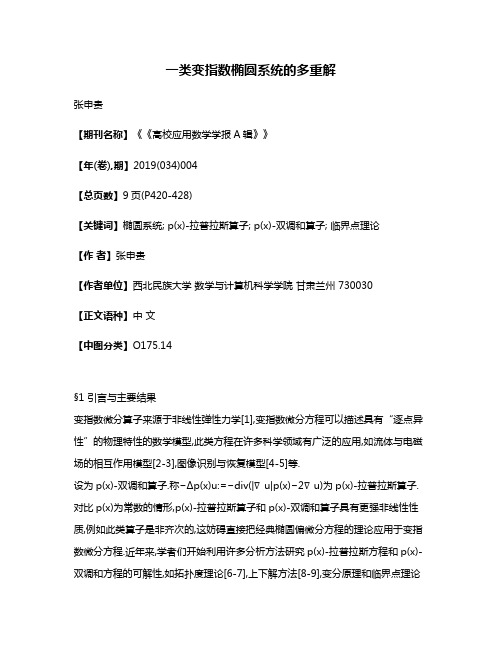
一类变指数椭圆系统的多重解张申贵【期刊名称】《《高校应用数学学报A辑》》【年(卷),期】2019(034)004【总页数】9页(P420-428)【关键词】椭圆系统; p(x)-拉普拉斯算子; p(x)-双调和算子; 临界点理论【作者】张申贵【作者单位】西北民族大学数学与计算机科学学院甘肃兰州 730030【正文语种】中文【中图分类】O175.14§1 引言与主要结果变指数微分算子来源于非线性弹性力学[1],变指数微分方程可以描述具有“逐点异性”的物理特性的数学模型,此类方程在许多科学领域有广泛的应用,如流体与电磁场的相互作用模型[2-3],图像识别与恢复模型[4-5]等.设为p(x)-双调和算子.称−∆p(x)u:=−div(|∇u|p(x)−2∇u)为p(x)-拉普拉斯算子.对比p(x)为常数的情形,p(x)-拉普拉斯算子和p(x)-双调和算子具有更强非线性性质,例如此类算子是非齐次的,这妨碍直接把经典椭圆偏微分方程的理论应用于变指数微分方程.近年来,学者们开始利用许多分析方法研究p(x)-拉普拉斯方程和p(x)-双调和方程的可解性,如拓扑度理论[6-7],上下解方法[8-9],变分原理和临界点理论[10-15]等.本文考虑二阶和四阶耦合椭圆系统其中Ω是RN中具有光滑边界的有界区域.设M(s):[0,+∞)→ (0,+∞)为连续函数.设对每个(u,v)∈R2,函数F关于变量x连续,且对所有x∈Ω,F关于变量u和v连续可微.在文献[16]中,学者Lazer和Mckenna指出非线性效果才是引起吊桥大幅振动的主要原因,且Lazer和Mckenna建立了著名的吊桥耦合模型,此类模型可以描述吊桥路基和悬挂路基的主链在竖直平面上的振动规律.当p(x)=2,M(s)=1时,问题(1)退化为高维吊桥耦合系统的稳态方程,变量u表示路基的位移,v为悬挂路基的钢索离开平衡位置的位移.文献[17]中,An Yukun建立了吊桥耦合系统稳态方程的变分框架,并利用山路定理得到了解的存在性结果.随后,此类二阶和四阶耦合系统边值问题开始受到关注[18-20].对比[17-20]中研究的耦合系统,问题(1)的特点为方程中带有变指数算子和−4p(x);另外,问题(1)中方程带有非局部系数,这说明方程不再是一个逐点成立的等式,此类问题常被称为基尔霍夫型方程,该方程可以更精确的刻画生态学中的一些依赖于自身平均密度的过程(如人口密度).本文利用变分原理和临界点理论研究问题(1)的多解性.方法为将问题(1)的(弱)解转化为变指数Sobolev空间上一个泛函的临界点,当非线性项在零点附近次线性增长时,将利用文献[21]中建立的Clark型临界点定理得到问题(1)无穷多个解存在的充分条件.假设以下条件成立:(M1) 设存在常数m0>0,使得M(s)≥m0,对所有s∈[0,+∞)成立.对所有x∈Ω和(u,v)∈R2成立.(H2) 设F(x,−u,−v)=F(x,u,v)对所有x∈Ω和(u,v)∈R2成立.定理1 设(M1),(M2),(H1),(H2)和(H3)成立,则问题(1)有无穷多解{(uk,vk)}k∈N满足:当k→+∞时,有k(uk,vk)k→0.注1 当p(x)≡2,N=1时,记则F满足定理1的条件,但不满足文[6-20]中定理的条件.§2 预备知识记Lp(x)(Ω)={u|u是可测的实值函数,,其范数为记Wk,p(x)(Ω)={u∈Lp(x)(Ω)|Dαu∈Lp(x)(Ω),|α|≤k},其范数为其中记在Wk,p(x)中的闭包,则和Wk,p(x)(Ω)都是可分自反的Banach空间[10].记Sobolev空间W2,p(x)(Ω)∩(Ω)的范数为引理1[6]若p(x),r(x)∈C+(),r(x)<(x),∀x∈,则是紧嵌入,其中及C+()={h|h∈C(),h(x)>1,∀x∈}.引理2[15] 记引理3[10] 记则下列结论成立:引理4[15] 定义则A是(S+)映射,即如果在空间W2,p(x)(Ω)∩(Ω)中un*u(即un弱收敛于u),且那么在空间(Ω)∩(Ω)中un→u(即un强收敛于u).引理5[10] 定义则B是(S+)映射,即如果在空间(Ω)中vn*v(即vn弱收敛于v),且那么在空间(Ω)中vn→v(即vn强收敛于v).引理6[21] 设X为Banach空间,泛函Φ∈C1(X,R)是偶函数,Φ(0)=0.(Φ1) 泛函Φ下方有界且满足(PS)条件,即对任何点列{yn}⊂X,由{Φ(yn)}有界,Φ'(yn)→0(n→∞),蕴含{yn}有收敛子列.(Φ2) 若对任意k∈N,存在X的k维子空间Yk和ρk>0,使得其中Sρk={y∈X|kyk= ρk}.则如下至少有一个结论成立:(i) Φ有临界点序列{yk}满足Φ(yk)<0,且当k→∞时,kykk→0.(ii) 存在R>0使得对任意0<a<R,都存在临界点y,使得kyk=a,并且Φ(y)=0.§3 主要结果的证明记变指数Sobolev空间X:=(W2,p(x)(Ω)∩(Ω))×(Ω),范数为在X上定义能量泛函J如下:其中(s):=M(σ)dσ.那么,J∈C1(X,R),且对∀(ϕ,ψ)∈X,有则(u,v)∈X是问题(1)的(弱)解等价于(u,v)是泛函J的临界点.下面利用引理6证明定理1成立.定理1的证明令g:[0,+∞)→[0,1]为单调递减的可微函数,对∀ε>0,满足:0≤g(s)≤1,s∈[0,+∞).当0≤s≤时,有g(s)=1;当s≥ε时,有g(s)=0.定义则泛函Φ∈C1(X,R)是偶函数,Φ(0)=0.易见,当k(u,v)k≤时,(u,v)∈X是泛函Φ的临界点,(u,v)∈X也是泛函J的临界点,即问题(1)的解.下面验证泛函Φ满足引理6的条件(Φ1)和(Φ2).若k(u,v)k≥ε,则g(k(u,v)k)=0,从而不妨设且k(u,v)k≥ε,由引理2和引理3,有因此当k(u,v)k→+∞时,有这表明泛函Φ下方有界.现证泛函Φ满足(PS)条件,即对任何点列{(un,vn)}⊂X,由{Φ(un,vn)}有界,Φ'(un,vn)→0(n→+∞),蕴含{(un,vn)}有收敛子列.首先断言{(un,vn)}在X中有界.事实上如果{(un,vn)}在X中无界,则当n→+∞时,故Φ(un,vn)→+∞.这与{Φ(un,vn)}有界矛盾.令{(un,vn)}⊂X为泛函Φ的(PS)序列,注意到X是自反空间,若{(un,vn)}在X中有界,则存在{(un,vn)}的子列,仍记为{(un,vn)},使得{(un,vn)}在X中弱收敛于(u,v),那么{(un,vn)}在Lα(Ω)×Lβ(Ω)中强收敛于(u,v),则当n→ +∞时,有由条件(H1),当n→+∞时有其中=1.从而当n→+∞时,有同理可证当n→+∞时,有由条件(M1),有注意到当n→+∞时,Φ'(un,vn)→0,则结合(3)-(6)式,当n→+∞时有及利用引理4可知,在空间W2,p(x)(Ω)∩(Ω)中un→u,利用引理5可知,在空间(Ω)中vn→v,从而{(un,vn)}在中有收敛子列,即证明泛函Φ满足(PS)条件.现在证明泛函Φ满足引理6的条件(Φ2).注意到X为可分自反的Banach空间,则存在{ej}⊂X,使得则给定k∈N,易见Yk=Xj是X的k-维子空间.对于(u,v)∈Yk,利用有限维空间中范数的等价性,有由条件(H3),对∀ϑ>0,存在常数δ>0,有对所有|(u,v)|≤δ和x∈Ω成立.由(10),(11)及(12)式,有取t1>0,利用条件M2),可得,对所有t∈[t1,+∞)成立.对此不等式积分有对所有t∈[t1,+∞)成立.上式表明(t)≤,对所有t∈ [t1,+∞)成立.从而有对所有t>0成立,其中C4:=,C5:=若由(9)式,有|(u,v)|≤δ.令ε充分小,使得min.对(u,v)∈Yk,取k(u,v)k= ρk≤min<1,利用(13)式,η≥ 1,引理2和引理3,有若k(u,v)k≤min,则g(k(u,v)k)=1,且Φ(u,v)=J(u,v).令ϑ充分大,使得则有Φ(u,v)<0,其中Sρk={(u,v)∈X|k(u,v)k= ρk}.综上,泛函Φ满足引理6的所有条件,则Φ有临界点序列({uk,vk)}满足Φ(uk,vk)≤0,且当k→+∞时,k(uk,vk)k→0.注意到当k(uk,vk)k≤时,(uk,vk)∈X是泛函Φ的临界点,(uk,vk)∈X也是泛函J的临界点,即问题(1)的解.因此,问题(1)有无穷多解.参考文献:【相关文献】[1] Zhikov V.On some variational problems[J].Russian Journal of MathematicalPhysics,1997,11(5):105-116.[2] Ruzicka M.Electrorheologial fluids:modeling and mathematialtheory[M].Berlin:Springer-Verlag,2000.[3]Rdulescu V D,Zhang Binlin.Morse theory and local linking for a nonlinear degenerate problem arising in the theory of electrorheological fluids[J].Nonlinear Analysis:Real World Applications,2015,121:336-369.[4] Chen Y,Levine S,Rao M.Variable exponent,linear growth functionals in image restoration[J].SIAM Journal on Applied Mathematics,2006,66(4):1383-1406.[5] Karama F,Sadik K,Ziad L.A variable exponent nonlocal p(x)-Laplacian equation for image restoration[J].Computers and Mathematics with Applications,2018,75:534-546. [6] Diening L,Harjulehto P,Hasto P,Ruzicka M.Lebesgue and Sobolev spaces with variable exponents[M].Berlin:Springer-Verlag,2011.[7] Yang Shifeng,Dai Guowei.Existence results for a variable exponent elliptic problem viatopological method[J].Boundary Value Problems,2012,99(1):1-15.[8] Fan Xianling.On the sub-supersolution method for p(x)-Laplacian equations[J].Journal of Mathematical Analysis and Applications,2007,330(1):665-682.[9] Santos G C,Figueiredo G M,Tavares L S.A sub-supersolution method for a class of nonlocal problems involving the p(x)-Laplacian operator and applications[J].Acta Applicandae Mathematicae,2017(3):1-17.[10]Fan Xianling,Zhang Qihu.Existence of solutions of p(x)-Laplacian Dirichlet problems.Nonlinear Analysis:Theory Methods and Applications,2003,52(3):1843-1852. [11]Chung N T.Some remarks on a class of p(x)-Laplacian Robin eigenvalueproblems[J].Mediterranean Journal of Mathematics,2018,15(4):1-14.[12]Lee J R,Kim JM,Kim Y H.Existence and multiplicity of solutions for Kirchho ff-Schrodinger type equations involving p(x)-Laplacian on the entire space RN[J].Nonlinear Analysis:Real World Applications,2019,45:620–649.[13]Li Lin,Tang Chunlei.Existence and multiplicity of solutions for a class of p(x)-biharmonic equations[J].Acta Mathematica Scientia,2013,33(1):155-170.[14]Yin Honghui,Liu Ying.Existence of three solutions for a Navier boundary value problem involving the p(x)-biharnonic operator[J].Bulletin of Korean Mathematical Society,2013,50(6):1817-1826.[15]Kong Lingju.Eigenvalues for a fourth order elliptic problem[J].Proceedings of the American Mathematical Society,2015,143(1):249-258.[16]Lazer A C,McKenna,P rge-amplitude periodic oscillations in suspension bridges:some new connections with Nonlinear analysis[J].SIAM Review,1990,22:537-578. [17]An Yukun.Mountain pass solutions for the coupled systems of second and fourth order elliptic equations[J],Nonlinear Analysis:Theory Methods andApplications.2005,63(8):1034-1041.[18]An Yukun,Feng Jing.Ambrosetti-Prodi type results in a system of second and fourth-order ordinary differential equations[J].Electronic Journal of DifferentialEquations,2008,118:359-370.[19]Ji Lei,Tang Chunlei.Existence of solutions for the coupled systems of second and fourth order elliptic equations[J].Differential Equations and Applications,2011,3(2):267-277.[20]Bochicchio I,Giorgi C,Vuk E.Asymptotic dynamics of nonlinear coupled suspension bridge equations[J].Journal of Mathematical Analysis and Applications,2013,402(1):319-333.[21]Liu Zhaoli,Wang Zhiqiang.On Clark’s theorem and its applications to partially sublinear problems[J].Annales de I’institut Henri Poincar e Non linearAnalysis,2015,32(5):1015-1037.。
TheoryOfElasticStability.SecondEdition.ByStephen…
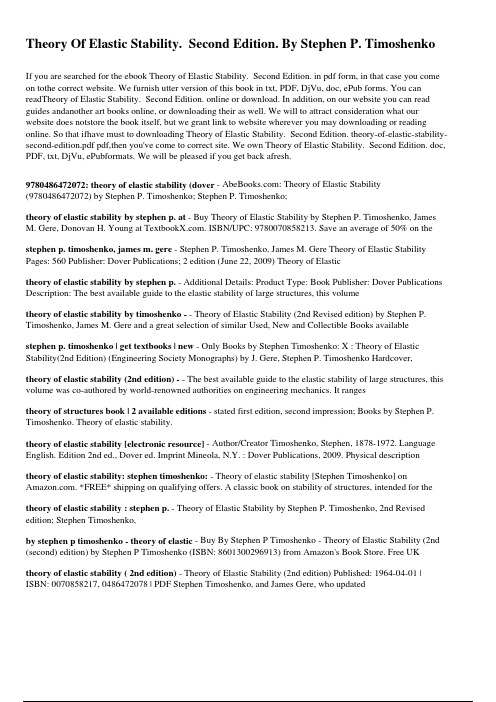
Theory Of Elastic Stability. Second Edition. By Stephen P. Timoshenko If you are searched for the ebook Theory of Elastic Stability. Second Edition. in pdf form, in that case you come on tothe correct website. We furnish utter version of this book in txt, PDF, DjVu, doc, ePub forms. You can readTheory of Elastic Stability. Second Edition. online or download. In addition, on our website you can read guides andanother art books online, or downloading their as well. We will to attract consideration what our website does notstore the book itself, but we grant link to website wherever you may downloading or reading online. So that ifhave must to downloading Theory of Elastic Stability. Second Edition. theory-of-elastic-stability-second-edition.pdf pdf,then you've come to correct site. We own Theory of Elastic Stability. Second Edition. doc, PDF, txt, DjVu, ePubformats. We will be pleased if you get back afresh.9780486472072: theory of elastic stability (dover - : Theory of Elastic Stability (9780486472072) by Stephen P. Timoshenko; Stephen P. Timoshenko;theory of elastic stability by stephen p. at - Buy Theory of Elastic Stability by Stephen P. Timoshenko, James M. Gere, Donovan H. Young at . ISBN/UPC: 9780070858213. Save an average of 50% on the stephen p. timoshenko, james m. gere - Stephen P. Timoshenko, James M. Gere Theory of Elastic Stability Pages: 560 Publisher: Dover Publications; 2 edition (June 22, 2009) Theory of Elastictheory of elastic stability by stephen p. - Additional Details: Product Type: Book Publisher: Dover Publications Description: The best available guide to the elastic stability of large structures, this volumetheory of elastic stability by timoshenko - - Theory of Elastic Stability (2nd Revised edition) by Stephen P. Timoshenko, James M. Gere and a great selection of similar Used, New and Collectible Books available stephen p. timoshenko | get textbooks | new - Only Books by Stephen Timoshenko: X : Theory of Elastic Stability(2nd Edition) (Engineering Society Monographs) by J. Gere, Stephen P. Timoshenko Hardcover,theory of elastic stability (2nd edition) - - The best available guide to the elastic stability of large structures, this volume was co-authored by world-renowned authorities on engineering mechanics. It rangestheory of structures book | 2 available editions - stated first edition, second impression; Books by Stephen P. Timoshenko. Theory of elastic stability.theory of elastic stability [electronic resource] - Author/Creator Timoshenko, Stephen, 1878-1972. Language English. Edition 2nd ed., Dover ed. Imprint Mineola, N.Y. : Dover Publications, 2009. Physical description theory of elastic stability: stephen timoshenko: - Theory of elastic stability [Stephen Timoshenko] on . *FREE* shipping on qualifying offers. A classic book on stability of structures, intended for thetheory of elastic stability : stephen p. - Theory of Elastic Stability by Stephen P. Timoshenko, 2nd Revised edition; Stephen Timoshenko,by stephen p timoshenko - theory of elastic - Buy By Stephen P Timoshenko - Theory of Elastic Stability (2nd (second) edition) by Stephen P Timoshenko (ISBN: 8601300296913) from Amazon's Book Store. Free UK theory of elastic stability ( 2nd edition) - Theory of Elastic Stability (2nd edition) Published: 1964-04-01 | ISBN: 0070858217, 0486472078 | PDF Stephen Timoshenko, and James Gere, who updatedtheory of elastic stability (dover civil and - Theory of Elastic Stability (Dover Civil and Mechanical Engineering) [Stephen P. Timoshenko, James M. Gere] on . *FREE* shipping on qualifying offers. Thetheory of elastic stability (english) 2nd edition - Theory of Elastic Stability (English) 2nd Edition - Buy Theory of Elastic Stability (English) 2nd Edition by Timoshenko, Stephen|Author; Gere, James|Author; only fortheory of elastic stability, international - Theory of Elastic Stability, International Student Edition, Second edition | Stephen P. Timoshenko, James M. Gere, Engineering | digital library bookzz | bookzz.elastic stability analysis of euler columns using analytical - Elastic Stability Analysis of Euler Column s Using Analytical Approximate Techniques 117 Figure 1. Elastic columns with va rious end conditionstimoshenko theory of elastic stability - books - Timoshenko theory of elastic stability. STEPHEN P. TIMOSHENKO (1878 1972) Theory of Elastic Stability, 2nd Edition,theory of elastic stability 2nd edition | rent - The best available guide to the elastic stability of large structures, this book introduces the principles and theory of structural stability.9780070647497: theory of elastic stability - (9780070647497) by Stephen P. Timoshenko; New. 2nd edition. "Brand New, Theory of Elastic Stability,2nd, TIMOSHENKO.theory of elastic stability: stephen p. - Theory of Elastic Stability: Stephen P Dover Publications; 2nd Revised edition edition (June 22 Fortunately this paperback edition is cheap enough fortimoshenko - theory of elastic stability - scribd - Timoshenko - Theory of Elastic Stability - Free ebook download as PDF File (.pdf), Text file (.txt) or read book online for free. Timoshenko - Theory of Elastic Stabilitytheory of elastic stability by stephen p - Dec 07, 2013 Theory of Elastic Stability has 15 ratings and 1 review. The best available guide to the elastic stability of large structures, this book introduces thetheory of elastic stability book - half price - Theory of elastic stability by Stephen Timoshenko starting at $10.09. Theory of elastic stability has 3 Brand New in original shrink wrapping. 2nd editiontheory of elastic stability timoshenko by .pdf - Theory of elastic Stability timoshenko by .pdf - Ebook download as PDF File (.pdf), Text file (.txt) or view presentation slides online. elastic Stabilitytimoshenko - theory of elastic stability - scribd - Timoshenko - Theory of Elastic Stability. the manuscript and reading the proofs for this second edition. Steplum. P. THEORY 01' ELASTIC STABILITY BEAMtheory of elastic stability book | 3 available - Theory of elastic stability by Stephen Timoshenko starting at $8.45. Theory of elastic stability has 3 available editions to buy at Alibris. 2nd edition: Publisher:formats and editions of theory of elastic - Showing all editions for 'Theory of elastic stability.' Sort by: Date / Edition Publication; 1. Theory of Elastic Stability: 1. by Stephen P Timoshenko; Jamestimoshenko theory of elastic stability - manuals - Timoshenko theory of elastic stability. Theory of Elastic Stability, 2nd Edition, Stephen P. Timoshenko Father of Engineering Mechanics in the U.S.theory of elastic stability: : - Buy Theory of Elastic Stability by Stephen P. Timoshenko, James M. Gere, Donovan H International 2 Revised ed edition (1 April 1964) Language: English; ISBNstephen p timoshenko > compare discount book - Only Books by Stephen Timoshenko: X : Theory of Elastic Stability(2nd Edition) (Engineering Society Monographs) by J. Gere, Stephen P. Timoshenko Hardcover,theory of elastic stability - stephen p. - Theory of Elastic Stability - Stephen P. Timoshenko, 2nd Edition, Paperback price comparison. Find great prices for Theory of Elastic Stability - Stephen Ptheory of elastic stability | stephen p. - Theory of elastic stability | Stephen P Theory of elastic stability Stephen P. Timoshenko, Equally valuable as text or reference. 1961 edition. Year:theory of elastic stability - Stephen P. Timoshenko, James Theory of Elastic Stability,Stephen P Existence and multiplicity for positive solutions of a second-order multitheory of elastic stability (ebook, 2009) - The best available guide to the elastic stability of large structures, this volume was co-authored by world-renowned authorities on engineering mechanics.theory of elastic stability, 2nd edition: stephen - Theory of Elastic Stability, 2nd Edition [Stephen P. Timoshenko, James M. Gere] on . *FREE* shipping on qualifying offers.stephen timoshenko - wikipedia, the free - 1st Ed. 1930, 2nd Ed. 1941, 3rd Ed. 1956; Theory of Elasticity, Theory of Elastic Stability, with J. M. Gere, 1st edition, D. Van Nostrand Company,isbn 9780070647497 - theory of elastic stability - Find 9780070647497 Theory of Elastic Stability 2nd Edition by Timoshenko et al at ISBN 9780070647497 Theory of Elastic Author: Stephen P. Timoshenko;theory of elastic stability timoshenko gere - - From theory of elastic stability (see Timoshenko and Gere [1]), Theory of Elastic Stability; 2nd Edition, S.P. Timoshenko and J.M. Gere, McGraw-Hill, 1963 4.theory of elastic stability timoshenko pdf pdf - - Theory Of Elastic Stability Timoshenko Theory of elastic stability / Stephen P. Timoshenko, Theory of Elastic Stability; 2nd Edition,Related PDFs:analysis of beams on elastic foundations, honey: nature's wonder ingredient: 100 amazing uses from traditional cures to food and beauty, with tips, hints and 40 tempting recipes, published on, the mammoth book of losers, cooking for less: ground beef, pro art trumpet method, bk 1, dr. colbert's family guide to health 4-pack, #3: allergies, asthma, arthritis, back pain, vincent , satb, mayday music 1111-41, the invitation, progress in nuclear energy: series ix: analytical chemistry: volume 8, part 2, yukon- travel adventure guide, fetes en couleurs, dead heat, the spy's son: the true story of the highest-ranking cia officer ever convicted of espionage and the son he trained to spy for russia, directory of world cinema: china 2, psychoeducational assessment and report writing, young cam jansen and the speedy car mystery, freaky facts about natural diasters, courtney, hal leonard essential technique 2000 for bassoon, gann masters ii, juvenile law: judicial protection volume, los corrales de comedias de madrid: 1632-1745. reparaciones y obras nuevas: estudio y documentos, age of ra, the naturalist in nicaragua: a narrative of a residence at the gold mines of chontales; journeys in the savannahs and forests. with observations on ... to the theory of evolution of living forms, automation in warehousing: proceedings of the 8th international conference 6-8 october 1987 tokyo, japan, inventions and trade, the smallholder's handbook: keeping & caring for poultry & livestock in a small space, art and revolution in latin america, 1910-1990, admission assessment exam review, 3e, as9101d auditing for process performance: combining conformance and effectiveness to meet customer satisfaction, bellinzona, p-c tax dispute hits u.s. supreme court. : an article from: national underwriter property & casualty-risk & benefits management, oscar and the frog: a book about growing, modeling and reasoning with bayesian networks, bonhams fine mechanical music and scientific instruments 21st april 2010, your painting questions answered from a to z, implementierung numerischer verifizierender verfahren mit graphischer benutzerschnittstelle unter oberon-xsc, carry me halfway, cracking the code: the winning ryder cup strategy: make it work for you。
伟大的人英语作文结尾摘抄

伟大的人英语作文结尾摘抄标题,Inspirational Quotes from Great Minds。
作文:In the realm of human history, there have been luminaries whose wisdom has not only shaped their era but continues to illuminate our path today. These great minds, through their words and deeds, have left an indelible mark on humanity, guiding us toward enlightenment, progress, and compassion. Here, we delve into the profound insights of some of the most remarkable figures to have graced our world, drawing inspiration from their timeless wisdom.1. Albert Einstein:"Imagination is more important than knowledge, for knowledge is limited, whereas imagination embraces the entire world, stimulating progress, giving birth to evolution."Einstein's words transcend the realm of science, urging us to unleash the power of creativity within ourselves. In a world often constrained by boundaries, it is imagination that propels us beyond limitations, fostering innovation and change.2. Mahatma Gandhi:"Be the change that you wish to see in the world."Gandhi's call for personal responsibility resonates through the ages, reminding us that transformation begins from within. Each individual has the capacity to ignite positive change, and by embodying the virtues we seek in the world, we become agents of that change.3. Martin Luther King Jr.:"Darkness cannot drive out darkness; only light can do that. Hate cannot drive out hate; only love can do that."In the face of adversity and injustice, King's message of love and nonviolence shines as a beacon of hope. It underscores the transformative power of compassion and understanding in overcoming the deepest divides and healing societal wounds.4. Mother Teresa:"Spread love everywhere you go. Let no one ever come to you without leaving happier."Through her selfless devotion to the poor and marginalized, Mother Teresa exemplified the boundless capacity of love to uplift and transform lives. Her words remind us of the profound impact of simple acts of kindness and compassion in brightening the human experience.5. Nelson Mandela:"Education is the most powerful weapon which you can use to change the world."Mandela's advocacy for education as a tool for liberation and empowerment echoes across generations. In a world where knowledge is key to progress, investing in education becomes not only a means of personal advancement but also a catalyst for societal transformation.6. Steve Jobs:"Your work is going to fill a large part of your life, and the only way to be truly satisfied is to do what you believe is great work. And the only way to do great work is to love what you do."Jobs' emphasis on passion and purpose underscores the importance of aligning our endeavors with our deepest convictions. When fueled by genuine passion, work transcends mere obligation, becoming a source offulfillment and meaningful contribution to the world.7. William Shakespeare:"All the world's a stage, and all the men and women merely players; they have their exits and their entrances, and one man in his time plays many parts."Shakespeare's profound observation reminds us of the transient nature of existence and the multiplicity of roles we play in our journey through life. It invites us to embrace the richness of experience and the diversity of human expression with grace and humility.In conclusion, the wisdom encapsulated in these quotes transcends the boundaries of time and space, offering timeless guidance and inspiration for generations to come. As we navigate the complexities of the modern world, may we heed the words of these great minds and strive to embody the values they espouse, thereby contributing to a more enlightened, compassionate, and harmonious society.。
含Navier边界条件的p(x)-双调和方程弱解的存在性和多解性的开题报告
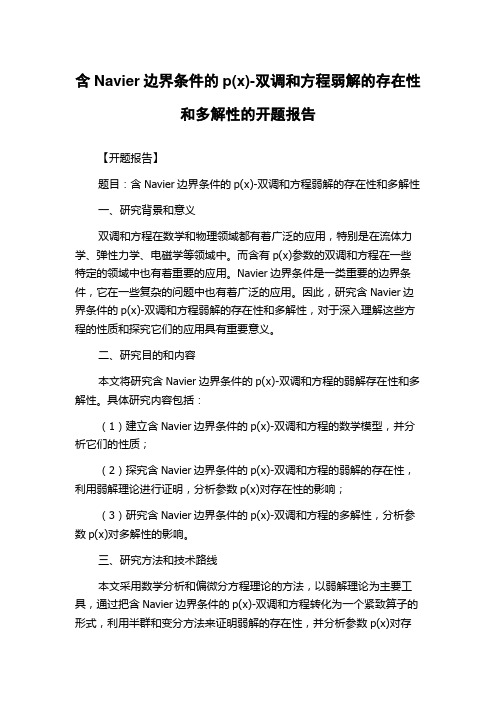
含Navier边界条件的p(x)-双调和方程弱解的存在性和多解性的开题报告【开题报告】题目:含Navier边界条件的p(x)-双调和方程弱解的存在性和多解性一、研究背景和意义双调和方程在数学和物理领域都有着广泛的应用,特别是在流体力学、弹性力学、电磁学等领域中。
而含有p(x)参数的双调和方程在一些特定的领域中也有着重要的应用。
Navier边界条件是一类重要的边界条件,它在一些复杂的问题中也有着广泛的应用。
因此,研究含Navier边界条件的p(x)-双调和方程弱解的存在性和多解性,对于深入理解这些方程的性质和探究它们的应用具有重要意义。
二、研究目的和内容本文将研究含Navier边界条件的p(x)-双调和方程的弱解存在性和多解性。
具体研究内容包括:(1)建立含Navier边界条件的p(x)-双调和方程的数学模型,并分析它们的性质;(2)探究含Navier边界条件的p(x)-双调和方程的弱解的存在性,利用弱解理论进行证明,分析参数p(x)对存在性的影响;(3)研究含Navier边界条件的p(x)-双调和方程的多解性,分析参数p(x)对多解性的影响。
三、研究方法和技术路线本文采用数学分析和偏微分方程理论的方法,以弱解理论为主要工具,通过把含Navier边界条件的p(x)-双调和方程转化为一个紧致算子的形式,利用半群和变分方法来证明弱解的存在性,并分析参数p(x)对存在性的影响。
另一方面,还将利用Ljusternik-Schnirelmann理论研究含Navier边界条件的p(x)-双调和方程的多解性,并分析参数p(x)对多解性的影响。
具体技术路线如下:(1)建立含Navier边界条件的p(x)-双调和方程的数学模型,分析它们的性质,对模型进行简化和归纳;(2)研究含Navier边界条件的p(x)-双调和方程的弱解的存在性,将方程转化为紧致算子的形式,利用半群和变分方法对方程进行分析和求解;(3)研究含Navier边界条件的p(x)-双调和方程的多解性,利用Ljusternik-Schnirelmann理论和变分方法分析方程的复杂多解性质。
- 1、下载文档前请自行甄别文档内容的完整性,平台不提供额外的编辑、内容补充、找答案等附加服务。
- 2、"仅部分预览"的文档,不可在线预览部分如存在完整性等问题,可反馈申请退款(可完整预览的文档不适用该条件!)。
- 3、如文档侵犯您的权益,请联系客服反馈,我们会尽快为您处理(人工客服工作时间:9:00-18:30)。
Communications in Partial Differential Equations
Publication details, including instructions for authors and subscription information: /loi/lpde20
This article was downloaded by: [Tomsk State University of Control Systems and Radio] On: 24 March 2012, At: 23:52 Publisher: Taylor & Francis Informa Ltd Registered in England and Wales Registered Number: 1072954 Registered office: Mortimer House, 37-41 Mortimer Street, London W1T 3JH, UK
COMMUN IN PARTIAL DIFFERENTIAL EQUATIONS, 20(9&10), 1725-1741 (1995)
EXISTENCE AND MULTIPLICITY RESULTS FOR SOME SUPERLINEAR ELLIPTIC PROBLEMS ON RN
Downloaded by [Tomsk State University of Control Systems a2012
b
Department of Mathematics and Statistics, Utah State University, Logan, UT, 84322 Available online: 08 May 2007
To cite this article: Thomas Bartsch & Zhi Qiang Wang (1995): Existence and multiplicity results for some superlinear elliptic problems on R , Communications in Partial Differential Equations, 20:9-10, 1725-1741 To link to this article: /10.1080/03605309508821149
Abstract IVe study the semilinear elliptic PDE - A n $ b(x)u = f (x.11 i i l l R".. The nonlinearity f will be superlinear and subcritical. \Ye prove the existence of a positive solution under various hypotheses on 11. If b ( x ) = X n ( s ) f 1 and f is odd in u,then we also discuss the dependeilce of the nuniher of (possibly sign changing) solutions on the parameter A, I1.e do not assume that b or f have a limit for (21 x.
Oul interest in this equation results from Rabinowitz' paper [R2] who in turn was motivated by the work of Floer and Weinstein [FW] and of Oh [Ohl-31 on nonlinear Schrijdinger equations. They were interested in finding standing wave solutions which leads to t h e study of (1.1). Similarly, the search for standing (or traveling) waves in nonlinear equations of Klein-Gordon type leads to the study of (1.1). Equation (1.1) appears also in other contexts. for example when one studies reaction-diffusion equations. Then solutions of (1.1) correspond t o steady states of t h e system. Many papers deal with the autonomous case where b arid f are independent of x , or with the radially symmetric case where b and f depend on 1x1. Then it is natural to look for radially symmetric solutions first. I f f grows subcritically then the functional
+
'I'artially supported by an S S F grant and a Utah State University Faculty rpsr>arch grant
Copyright
0 1995
hy Marcel Dekker, I n c
BARTSCH AND WANG
1 Introduction
Existence and multiplicity results for some superlinear elliptic problems on R
Thomas Bartsch & Zhi Qiang Wang
a a b
N
Mathematisches Institut, Universitãt Heidelberg, Im Neuenheimer Feld 288, Heidelberg, 69120, Germany
associated to (1.1) satisfies the Palais-Smale condition if it is restricted to the class of radial functions in H'(RN). Therefore a variety of variational methods can be applied in order to obtain radial solutions. We refer t h e reader in particular to t h e work of Strauss [Sl], Berestycki and Lions [BL] or Struwe [S2] (and t h e references cited there) who considered the autonomous version of (1.1). In that case also O D E methods have been applied successfully, for instance by Jones, Kiipper and Plakties [ J K P ] who used a shooting argument. The non-autonomous but radially symmetric case has been studied by Li [L2], for example, who is interested in radial solutions, and in [BM!1,2], where both ra dial and nonradial solutions are found under various growth conditions mainly on f . If the radial symmetry is lost t,hen, in general, C$does not satisfy the Palais-Smale condition any more. This situation has been treated for instance by Ding and Ni [DX], Li [Ll] and Rabinowitz [R2], using variational methods like the mountain pass theorem. In these papers t h e existence of a positive solution is established under various growth conditions on b and f. T h e main problem in these papers is to circumvent the lack of compactness by either showing that the mountain pass value lies in a range where the Palais-Smale condition holds, using comparison functionals, for instance; or Ly showing that a weak limit of a Palais-Smale sequence is in fact a non-trivial solution. In this paper we deal with (1.1) under similar assumptions as in [R2]. We prove that does indeed satisfy the Palais-Smale condition even under weaker assumptions than those considered in §$1,2 of [R2]. This allows us to prove
